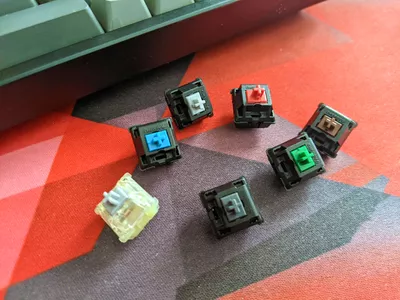
Updated Lumafusion for Mac A Complete Guide to Installation and Alternatives

Lumafusion for Mac: A Complete Guide to Installation and Alternatives
Lumafusion for Mac: Install It or Get Alternatives

Max Wales
Mar 27, 2024• Proven solutions
LumaFusion is one of those applications that cannot go unmentioned in the list of best video editors for touch screen users. And for a reason: LumaFusion incorporates all that is expected from a good video editing software.
Scroll down to find more about LumaFusion Mac, how to install LumaFusion on M1-based Mac and iOS devices, and its alternatives!
- Part 1: What is Lumafusion
- Part 2: Lumafusion Can Run on M1-Based Mac
- Part 3: Lumafusion Alternatives on Mac
Part 1: What is Lumafusion?
LumaFusion is a powerful multitrack video editor that provides you with limitless options to edit a video to the finest quality, especially on touch screens. Recommended for journalists, filmmakers, and professional video producers, LumaFusion is the best application if you are looking to edit videos on the go!
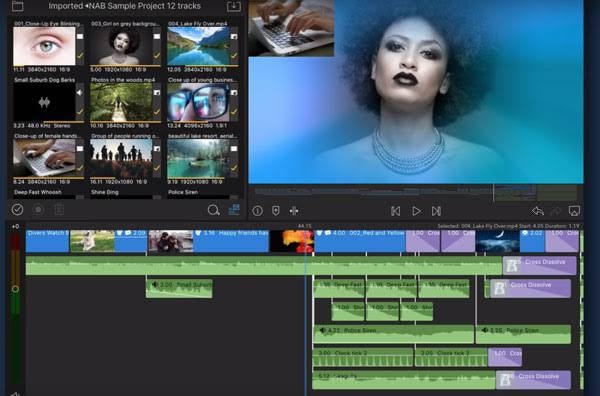
Key Features:
- Employ up to six layers of video and audio tracks simultaneously
- Use preset transition options or create one yourself
- Display the edited video on another monitor in real-time while editing on the other
- Fine-tune and keyframe audio levels to perfect mixes
- Use multilayer titles with the desired shapes and sizes
- Work in frame rates from 18fps to 240fps and more!
Part 2: Lumafusion can Run on M1-Based Mac
While LumaFusion does not have a Mac version yet, it made clear that M1-based Mac supports the LumaFusion to run on a macOS environment. Yes, it might get inconvenient if you are not used to mouse navigation. Still, all features remain the same, and you can edit the videos to the same level. Plus, given the recent upgrades, LumaFusion has enabled users to change the touch option to mouse and keyboard, so you can customize the options accordingly and even use keyboard shortcuts to work seamlessly.
How to install Lumafusion
Here’s how to install LumaFusion on M1-based Mac:
- Open the App Store.
- Type in LumaFusion in the Search menu.
- Navigate to the right pane and find the LumaFusion application from the list.
- And select Get to install the LumaFusion application on M1-based Mac.
Once LumaFusion is installed on the Mac, you can work around the software like on iOS devices. All you have to do is go to Touch Alternatives options to change the customizing options.
Part 3: LumaFusion Alternatives on Mac
Although mighty and powerful, LumaFusion can be an annoyance to some based on personal preference. So, we are listing the two best alternatives of LumaFusion that includes almost all the features and enables you to edit the video to the same level.
1. Wondershare Filmora for Mac[for beginner and intermediate]
Filmora for Mac is suitable for all i.e., beginners, intermediate, and advanced video editors who want to utilize all the professional options yet need a simple interface. And given this smooth shift from beginners to experts — we recommend Filmora to the beginners and intermediate users who want to make a career or follow their passion for video-editing for years to come.
Coming to the features, Filmora includes all that is needed to enhance the video clips’ quality and give it unique and personalized effects.
Here are the key features of Filmora:
- Intuitive and simple interface, allowing even the least video-editor literates to personalize their videos to the full extent
- Pre-created filters and color pallets to color-correct the videos or you can utilize the professional color wheel and automated color-correction features to allow users to balance the color themselves
- Create simple animations with one-click preset options or take animation into your hands and personalize every aspect of the video manually, including position, size, opacity, and volume
- Includes a library of royalty-free music to incorporate tunes to the videos or you can utilize customizable options to bring consistency to your sound
- Large effects library with numerous customizing options and built-in filters, effects, overlays, and transitions to apply them with one-click
You may also interested in: How to edit video with Filmora
2. Final Cut Pro
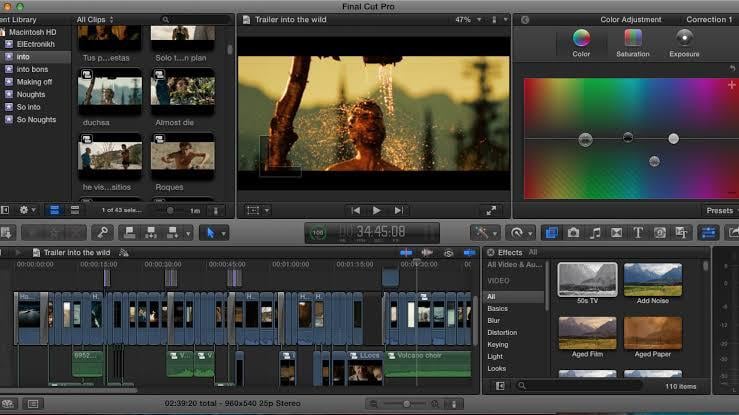
Apple’s native Final Cut Pro X is another perfect alternative that has managed to make the top list when it comes to the best video editing software for the Mac since its release in 2011. And although it’s a pricey option, Final Cut Pro X offers a 90-day trial period to judge the application for yourself. Of course, the trial version excludes some additional content like extra sound effects, presets, the space designer plugin, and advanced video formats. Still, it should be enough to review the application.
Coming to the features, Final Cut Pro X takes things to a different level and offers you the best-in-trade functions to edit the videos to perfection. Including superior organization tools, libraries, ratings, tagging, auto analysis for faces, scenes — the interface of Final Cut Pro X speaks of the effort the designers have put into the software. Moreover, the multi-cam support, multiple later editing, audio effects, and the recent upgrade of smoothing 360-degree footage and HDR modes have shown that Apple will leave no stone unturned when it comes to perfecting its native professional video-editing tool, i.e., Final Cut Pro X.
However, there is a learning curve if you are new to Final Cut Pro X (regardless of whether you are an expert or not), as it incorporates a unique magnetic, trackless timeline that is not common to the video-editing software. But that initial learning time is worth it because once you start utilizing Final Cut Pro X, you will not see (or like) any other software in the industry — given the regular and timely updates to the application.
Can’t choose between Final Cut Pro and Lumafusion for professional video editing? This article may help you: Final Cut Pro vs. Lumafusion, Which Suits You Better
Conclusion
While LumaFusion can be installed on the new M1-Based Macs, it is not that great to work on it (especially, if you are used to the touch version). And that is why this guide list the two-best alternatives to LumaFusion, i.e., Filmora and Final Cut Pro.And we highly recommend Filmora to all non-professional users.

Max Wales
Max Wales is a writer and a lover of all things video.
Follow @Max Wales
Max Wales
Mar 27, 2024• Proven solutions
LumaFusion is one of those applications that cannot go unmentioned in the list of best video editors for touch screen users. And for a reason: LumaFusion incorporates all that is expected from a good video editing software.
Scroll down to find more about LumaFusion Mac, how to install LumaFusion on M1-based Mac and iOS devices, and its alternatives!
- Part 1: What is Lumafusion
- Part 2: Lumafusion Can Run on M1-Based Mac
- Part 3: Lumafusion Alternatives on Mac
Part 1: What is Lumafusion?
LumaFusion is a powerful multitrack video editor that provides you with limitless options to edit a video to the finest quality, especially on touch screens. Recommended for journalists, filmmakers, and professional video producers, LumaFusion is the best application if you are looking to edit videos on the go!

Key Features:
- Employ up to six layers of video and audio tracks simultaneously
- Use preset transition options or create one yourself
- Display the edited video on another monitor in real-time while editing on the other
- Fine-tune and keyframe audio levels to perfect mixes
- Use multilayer titles with the desired shapes and sizes
- Work in frame rates from 18fps to 240fps and more!
Part 2: Lumafusion can Run on M1-Based Mac
While LumaFusion does not have a Mac version yet, it made clear that M1-based Mac supports the LumaFusion to run on a macOS environment. Yes, it might get inconvenient if you are not used to mouse navigation. Still, all features remain the same, and you can edit the videos to the same level. Plus, given the recent upgrades, LumaFusion has enabled users to change the touch option to mouse and keyboard, so you can customize the options accordingly and even use keyboard shortcuts to work seamlessly.
How to install Lumafusion
Here’s how to install LumaFusion on M1-based Mac:
- Open the App Store.
- Type in LumaFusion in the Search menu.
- Navigate to the right pane and find the LumaFusion application from the list.
- And select Get to install the LumaFusion application on M1-based Mac.
Once LumaFusion is installed on the Mac, you can work around the software like on iOS devices. All you have to do is go to Touch Alternatives options to change the customizing options.
Part 3: LumaFusion Alternatives on Mac
Although mighty and powerful, LumaFusion can be an annoyance to some based on personal preference. So, we are listing the two best alternatives of LumaFusion that includes almost all the features and enables you to edit the video to the same level.
1. Wondershare Filmora for Mac[for beginner and intermediate]
Filmora for Mac is suitable for all i.e., beginners, intermediate, and advanced video editors who want to utilize all the professional options yet need a simple interface. And given this smooth shift from beginners to experts — we recommend Filmora to the beginners and intermediate users who want to make a career or follow their passion for video-editing for years to come.
Coming to the features, Filmora includes all that is needed to enhance the video clips’ quality and give it unique and personalized effects.
Here are the key features of Filmora:
- Intuitive and simple interface, allowing even the least video-editor literates to personalize their videos to the full extent
- Pre-created filters and color pallets to color-correct the videos or you can utilize the professional color wheel and automated color-correction features to allow users to balance the color themselves
- Create simple animations with one-click preset options or take animation into your hands and personalize every aspect of the video manually, including position, size, opacity, and volume
- Includes a library of royalty-free music to incorporate tunes to the videos or you can utilize customizable options to bring consistency to your sound
- Large effects library with numerous customizing options and built-in filters, effects, overlays, and transitions to apply them with one-click
You may also interested in: How to edit video with Filmora
2. Final Cut Pro

Apple’s native Final Cut Pro X is another perfect alternative that has managed to make the top list when it comes to the best video editing software for the Mac since its release in 2011. And although it’s a pricey option, Final Cut Pro X offers a 90-day trial period to judge the application for yourself. Of course, the trial version excludes some additional content like extra sound effects, presets, the space designer plugin, and advanced video formats. Still, it should be enough to review the application.
Coming to the features, Final Cut Pro X takes things to a different level and offers you the best-in-trade functions to edit the videos to perfection. Including superior organization tools, libraries, ratings, tagging, auto analysis for faces, scenes — the interface of Final Cut Pro X speaks of the effort the designers have put into the software. Moreover, the multi-cam support, multiple later editing, audio effects, and the recent upgrade of smoothing 360-degree footage and HDR modes have shown that Apple will leave no stone unturned when it comes to perfecting its native professional video-editing tool, i.e., Final Cut Pro X.
However, there is a learning curve if you are new to Final Cut Pro X (regardless of whether you are an expert or not), as it incorporates a unique magnetic, trackless timeline that is not common to the video-editing software. But that initial learning time is worth it because once you start utilizing Final Cut Pro X, you will not see (or like) any other software in the industry — given the regular and timely updates to the application.
Can’t choose between Final Cut Pro and Lumafusion for professional video editing? This article may help you: Final Cut Pro vs. Lumafusion, Which Suits You Better
Conclusion
While LumaFusion can be installed on the new M1-Based Macs, it is not that great to work on it (especially, if you are used to the touch version). And that is why this guide list the two-best alternatives to LumaFusion, i.e., Filmora and Final Cut Pro.And we highly recommend Filmora to all non-professional users.

Max Wales
Max Wales is a writer and a lover of all things video.
Follow @Max Wales
Max Wales
Mar 27, 2024• Proven solutions
LumaFusion is one of those applications that cannot go unmentioned in the list of best video editors for touch screen users. And for a reason: LumaFusion incorporates all that is expected from a good video editing software.
Scroll down to find more about LumaFusion Mac, how to install LumaFusion on M1-based Mac and iOS devices, and its alternatives!
- Part 1: What is Lumafusion
- Part 2: Lumafusion Can Run on M1-Based Mac
- Part 3: Lumafusion Alternatives on Mac
Part 1: What is Lumafusion?
LumaFusion is a powerful multitrack video editor that provides you with limitless options to edit a video to the finest quality, especially on touch screens. Recommended for journalists, filmmakers, and professional video producers, LumaFusion is the best application if you are looking to edit videos on the go!

Key Features:
- Employ up to six layers of video and audio tracks simultaneously
- Use preset transition options or create one yourself
- Display the edited video on another monitor in real-time while editing on the other
- Fine-tune and keyframe audio levels to perfect mixes
- Use multilayer titles with the desired shapes and sizes
- Work in frame rates from 18fps to 240fps and more!
Part 2: Lumafusion can Run on M1-Based Mac
While LumaFusion does not have a Mac version yet, it made clear that M1-based Mac supports the LumaFusion to run on a macOS environment. Yes, it might get inconvenient if you are not used to mouse navigation. Still, all features remain the same, and you can edit the videos to the same level. Plus, given the recent upgrades, LumaFusion has enabled users to change the touch option to mouse and keyboard, so you can customize the options accordingly and even use keyboard shortcuts to work seamlessly.
How to install Lumafusion
Here’s how to install LumaFusion on M1-based Mac:
- Open the App Store.
- Type in LumaFusion in the Search menu.
- Navigate to the right pane and find the LumaFusion application from the list.
- And select Get to install the LumaFusion application on M1-based Mac.
Once LumaFusion is installed on the Mac, you can work around the software like on iOS devices. All you have to do is go to Touch Alternatives options to change the customizing options.
Part 3: LumaFusion Alternatives on Mac
Although mighty and powerful, LumaFusion can be an annoyance to some based on personal preference. So, we are listing the two best alternatives of LumaFusion that includes almost all the features and enables you to edit the video to the same level.
1. Wondershare Filmora for Mac[for beginner and intermediate]
Filmora for Mac is suitable for all i.e., beginners, intermediate, and advanced video editors who want to utilize all the professional options yet need a simple interface. And given this smooth shift from beginners to experts — we recommend Filmora to the beginners and intermediate users who want to make a career or follow their passion for video-editing for years to come.
Coming to the features, Filmora includes all that is needed to enhance the video clips’ quality and give it unique and personalized effects.
Here are the key features of Filmora:
- Intuitive and simple interface, allowing even the least video-editor literates to personalize their videos to the full extent
- Pre-created filters and color pallets to color-correct the videos or you can utilize the professional color wheel and automated color-correction features to allow users to balance the color themselves
- Create simple animations with one-click preset options or take animation into your hands and personalize every aspect of the video manually, including position, size, opacity, and volume
- Includes a library of royalty-free music to incorporate tunes to the videos or you can utilize customizable options to bring consistency to your sound
- Large effects library with numerous customizing options and built-in filters, effects, overlays, and transitions to apply them with one-click
You may also interested in: How to edit video with Filmora
2. Final Cut Pro

Apple’s native Final Cut Pro X is another perfect alternative that has managed to make the top list when it comes to the best video editing software for the Mac since its release in 2011. And although it’s a pricey option, Final Cut Pro X offers a 90-day trial period to judge the application for yourself. Of course, the trial version excludes some additional content like extra sound effects, presets, the space designer plugin, and advanced video formats. Still, it should be enough to review the application.
Coming to the features, Final Cut Pro X takes things to a different level and offers you the best-in-trade functions to edit the videos to perfection. Including superior organization tools, libraries, ratings, tagging, auto analysis for faces, scenes — the interface of Final Cut Pro X speaks of the effort the designers have put into the software. Moreover, the multi-cam support, multiple later editing, audio effects, and the recent upgrade of smoothing 360-degree footage and HDR modes have shown that Apple will leave no stone unturned when it comes to perfecting its native professional video-editing tool, i.e., Final Cut Pro X.
However, there is a learning curve if you are new to Final Cut Pro X (regardless of whether you are an expert or not), as it incorporates a unique magnetic, trackless timeline that is not common to the video-editing software. But that initial learning time is worth it because once you start utilizing Final Cut Pro X, you will not see (or like) any other software in the industry — given the regular and timely updates to the application.
Can’t choose between Final Cut Pro and Lumafusion for professional video editing? This article may help you: Final Cut Pro vs. Lumafusion, Which Suits You Better
Conclusion
While LumaFusion can be installed on the new M1-Based Macs, it is not that great to work on it (especially, if you are used to the touch version). And that is why this guide list the two-best alternatives to LumaFusion, i.e., Filmora and Final Cut Pro.And we highly recommend Filmora to all non-professional users.

Max Wales
Max Wales is a writer and a lover of all things video.
Follow @Max Wales
Max Wales
Mar 27, 2024• Proven solutions
LumaFusion is one of those applications that cannot go unmentioned in the list of best video editors for touch screen users. And for a reason: LumaFusion incorporates all that is expected from a good video editing software.
Scroll down to find more about LumaFusion Mac, how to install LumaFusion on M1-based Mac and iOS devices, and its alternatives!
- Part 1: What is Lumafusion
- Part 2: Lumafusion Can Run on M1-Based Mac
- Part 3: Lumafusion Alternatives on Mac
Part 1: What is Lumafusion?
LumaFusion is a powerful multitrack video editor that provides you with limitless options to edit a video to the finest quality, especially on touch screens. Recommended for journalists, filmmakers, and professional video producers, LumaFusion is the best application if you are looking to edit videos on the go!

Key Features:
- Employ up to six layers of video and audio tracks simultaneously
- Use preset transition options or create one yourself
- Display the edited video on another monitor in real-time while editing on the other
- Fine-tune and keyframe audio levels to perfect mixes
- Use multilayer titles with the desired shapes and sizes
- Work in frame rates from 18fps to 240fps and more!
Part 2: Lumafusion can Run on M1-Based Mac
While LumaFusion does not have a Mac version yet, it made clear that M1-based Mac supports the LumaFusion to run on a macOS environment. Yes, it might get inconvenient if you are not used to mouse navigation. Still, all features remain the same, and you can edit the videos to the same level. Plus, given the recent upgrades, LumaFusion has enabled users to change the touch option to mouse and keyboard, so you can customize the options accordingly and even use keyboard shortcuts to work seamlessly.
How to install Lumafusion
Here’s how to install LumaFusion on M1-based Mac:
- Open the App Store.
- Type in LumaFusion in the Search menu.
- Navigate to the right pane and find the LumaFusion application from the list.
- And select Get to install the LumaFusion application on M1-based Mac.
Once LumaFusion is installed on the Mac, you can work around the software like on iOS devices. All you have to do is go to Touch Alternatives options to change the customizing options.
Part 3: LumaFusion Alternatives on Mac
Although mighty and powerful, LumaFusion can be an annoyance to some based on personal preference. So, we are listing the two best alternatives of LumaFusion that includes almost all the features and enables you to edit the video to the same level.
1. Wondershare Filmora for Mac[for beginner and intermediate]
Filmora for Mac is suitable for all i.e., beginners, intermediate, and advanced video editors who want to utilize all the professional options yet need a simple interface. And given this smooth shift from beginners to experts — we recommend Filmora to the beginners and intermediate users who want to make a career or follow their passion for video-editing for years to come.
Coming to the features, Filmora includes all that is needed to enhance the video clips’ quality and give it unique and personalized effects.
Here are the key features of Filmora:
- Intuitive and simple interface, allowing even the least video-editor literates to personalize their videos to the full extent
- Pre-created filters and color pallets to color-correct the videos or you can utilize the professional color wheel and automated color-correction features to allow users to balance the color themselves
- Create simple animations with one-click preset options or take animation into your hands and personalize every aspect of the video manually, including position, size, opacity, and volume
- Includes a library of royalty-free music to incorporate tunes to the videos or you can utilize customizable options to bring consistency to your sound
- Large effects library with numerous customizing options and built-in filters, effects, overlays, and transitions to apply them with one-click
You may also interested in: How to edit video with Filmora
2. Final Cut Pro

Apple’s native Final Cut Pro X is another perfect alternative that has managed to make the top list when it comes to the best video editing software for the Mac since its release in 2011. And although it’s a pricey option, Final Cut Pro X offers a 90-day trial period to judge the application for yourself. Of course, the trial version excludes some additional content like extra sound effects, presets, the space designer plugin, and advanced video formats. Still, it should be enough to review the application.
Coming to the features, Final Cut Pro X takes things to a different level and offers you the best-in-trade functions to edit the videos to perfection. Including superior organization tools, libraries, ratings, tagging, auto analysis for faces, scenes — the interface of Final Cut Pro X speaks of the effort the designers have put into the software. Moreover, the multi-cam support, multiple later editing, audio effects, and the recent upgrade of smoothing 360-degree footage and HDR modes have shown that Apple will leave no stone unturned when it comes to perfecting its native professional video-editing tool, i.e., Final Cut Pro X.
However, there is a learning curve if you are new to Final Cut Pro X (regardless of whether you are an expert or not), as it incorporates a unique magnetic, trackless timeline that is not common to the video-editing software. But that initial learning time is worth it because once you start utilizing Final Cut Pro X, you will not see (or like) any other software in the industry — given the regular and timely updates to the application.
Can’t choose between Final Cut Pro and Lumafusion for professional video editing? This article may help you: Final Cut Pro vs. Lumafusion, Which Suits You Better
Conclusion
While LumaFusion can be installed on the new M1-Based Macs, it is not that great to work on it (especially, if you are used to the touch version). And that is why this guide list the two-best alternatives to LumaFusion, i.e., Filmora and Final Cut Pro.And we highly recommend Filmora to all non-professional users.

Max Wales
Max Wales is a writer and a lover of all things video.
Follow @Max Wales
13 Windows Movie Maker Alternatives You Need to Try
Windows Movie Maker has been a cornerstone tool for video editors for quite a while. There are a lot of amateurs who’ve made use of the free program and have done wonders with it. As it is discontinued, many Windows Movie Maker alternatives claim to offer ‘just the right video editing tool for you,’ few can live up to their promises—and most are very expensive.
We have ten other programs that can be used to create videos that include everything from Apple iMovie to other basic alternatives.
So whether you’re a beginner who wants to learn how to make a movie, a pro looking for an excellent alternative to Windows Movie Maker, or someone who wants to make a simple slide presentation or online video, you’re bound to find a video creation program here.
- Wondershare Filmora
- Avidemux Video Editor
- VirtualDub
- Sony Vegas Movie Studio
- WeVideo
- Lightworks
- ShotCut
- OpenShot
- Movavi Video Editor Plus
- VSDC Free Video Editor
- VideoPad Video Editor
- HitFilm
- Magix Movie Studio
- How To Edit a Video With a Windows Movie Maker Alternative
- Hot FAQs on Windows Movie Maker Alternatives
Part 1: Top 3 Picks for Windows Movie Maker Alternatives
The world’s best video editing software is about to change. We look at three of the most popular and valuable alternatives to Windows Movie Maker.
You will need to consider these alternatives to ensure they meet your expectations and needs.
1. Wondershare Filmora - Best Overall

Filmora is the best Windows Movie Maker Alternative designed according to your convenience.
Ratings: 4.4 Stars out 5
Starting from $49.99
2. Magix Movie Studio - Best for Collages

This alternative offers a variety of tools and plugins for anyone who wants to create professional-level videos in under a minute.
Download on Windows
Ratings: 4 stars out of 5
30-day free trials, then starts from $69.99 all the way to $129
3. Avidemux Video Editor - Best Open-Source Editor

An open-source editor that supports a wide range of formats is free! Avidemux has an interface similar to Windows Movie Maker, which makes it a perfect alternative.
Download on Windows
Ratings: 4.0 stars out of 5
Free Trial
Part 2: Ultimate Overview on 13 Best Alternatives to Windows Movie Maker
We live in visual culture, and we constantly see, capture, upload, and share videos on our smartphones, tablets, and laptops. So, it is only natural that more people seek ways to edit their videos. Windows Movie Maker was one of the most popular video editing apps. So it’s time to dig into the best Windows Movie Maker alternatives, which are arguably better and feature-rich.
| Software | OS | Media Resources | AI editing | Easy to Use | Free Trial |
|---|---|---|---|---|---|
| Wondershare Filmora | WindowsMacMobile | Yes | Yes | Yes | Yes |
| Avidemux | WindowsOS XLinuxBSD | Yes | No | Yes | Yes |
| Virtual Dub | Windows | No | No | Yes | Yes |
| Vegas Movie Studio | Windows | Yes | Yes | No | No |
| WeVideo | Online | Yes | No | Yes | Yes |
| Lightworks | LinuxOS X Windows | Yes | Yes | No | No |
| ShotCut | WindowsMacLinuxBSD | Yes | No | No | Yes |
| OpenShot | WindowsMacLinuxChrome OS | Yes | No | Yes | Yes |
| Movavi Plus | WindowsMac | Yes | No | Yes | Yes |
| VSDC | Windows | Yes | No | Yes | Yes |
| VideoPad | WindowsMaciPad/iPhone | Yes | No | Yes | Yes |
| HitFilm | WindowsMac | Yes | Yes | Yes | Yes |
| Magix Movie Studio | Windows | Yes | Yes | No | Yes |
Part 3: 13 Best Windows Movie Maker Alternatives for Windows
As we all know, Windows Movie Maker is the most used and trusted tool for creating videos in Windows. With its unique features and user-friendly interface, people often use this software to develop short and entertaining videos.
However, the fact is that Windows Movie Maker is not the current best video editing software for creating complex video projects. For this reason, we compiled a list of the 12 best alternatives to offer you a better option for Windows Movie Maker.
1. Wondershare Filmora
Filmora 11 is a powerful, easy-to-use video editor specially designed to streamline your workflow and save you hours weekly. It supports everything from Windows, Mac, and IOS to Android. The latest update to the flagship app includes several key enhancements that result in a much more efficient video creation workflow and one that’s easier to use than its rivals.
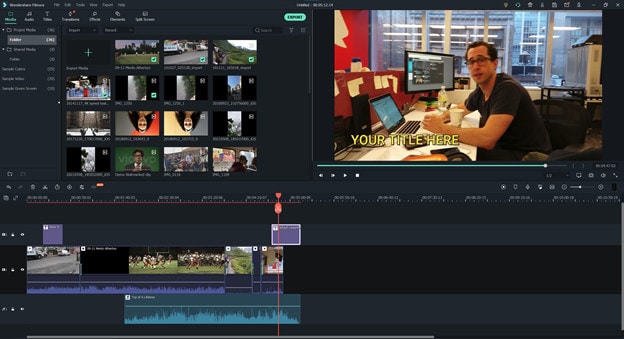
Key features
- Preset Templates
- Instant Mode
- Motion Tracking
- AI Editing Effects
- Auto Synchronization
- Plug-ins
Price
- Annual Plan: $49.99
- Perpetual Plan: $79.99
Pros
- Seamless interface for beginners
- Great customer support
- Plenty of effects and preset templates
- 4K video output options
Cons
- Rendering requires too much time
- The mobile app requires separate subscription
Supported OS: Windows , Mac , iOS , Android , iPad
G2 Ratings: 4.4 stars out of 5
Summary
Filmora’s intuitive interface allows experienced and brand-new users to create incredible videos with flawless special effects. Its high ratings and multiple supported formats make it quite popular among users.
2. Avidemux Video Editor
If you are a beginner and want to use a free, open-source software program for basic video editing, then Avidemux is a good choice. The interface is not as fancy as it could be, but there are some presets that’ll save you a lot of time. Avidemux is a cross-platform video editor that allows you to create custom videos, but it doesn’t feature the ability to share the edited footage to social media directly,
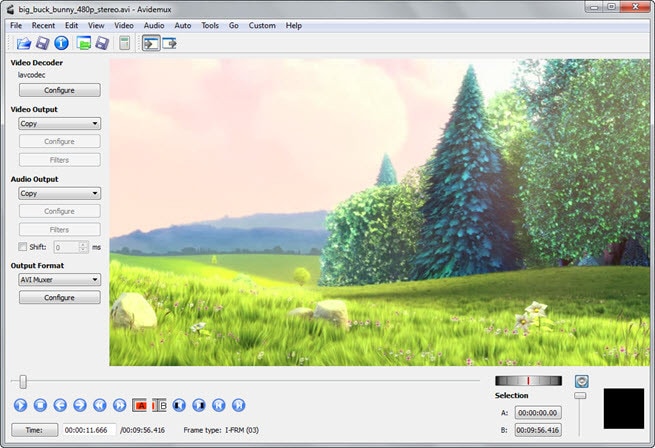
Key features
- Video and Audio Filters
- Support Popular Formats
- Convert Video For Archiving or Publishing
Price: Free
Pros
- It can convert Video To A Smaller Size
- Easy cut, trim, split video
Cons
- Out-dated UI
- Lacks sharing option
Supported OS: Windows , OS X , Linux , BSD
Uptodown Ratings: 4.0 stars out of 5
Summary
An open-source video editor that supports most formats. Due to its obsolete UI and lack of sharing features, Avidemux has average ratings.
3. VirtualDub
This open-source software is user-friendly and allows users with little experience to navigate the software without much trouble. It supports 3rd party apps and also offers batch-processing, which means working on multiple videos simultaneously makes it possible.
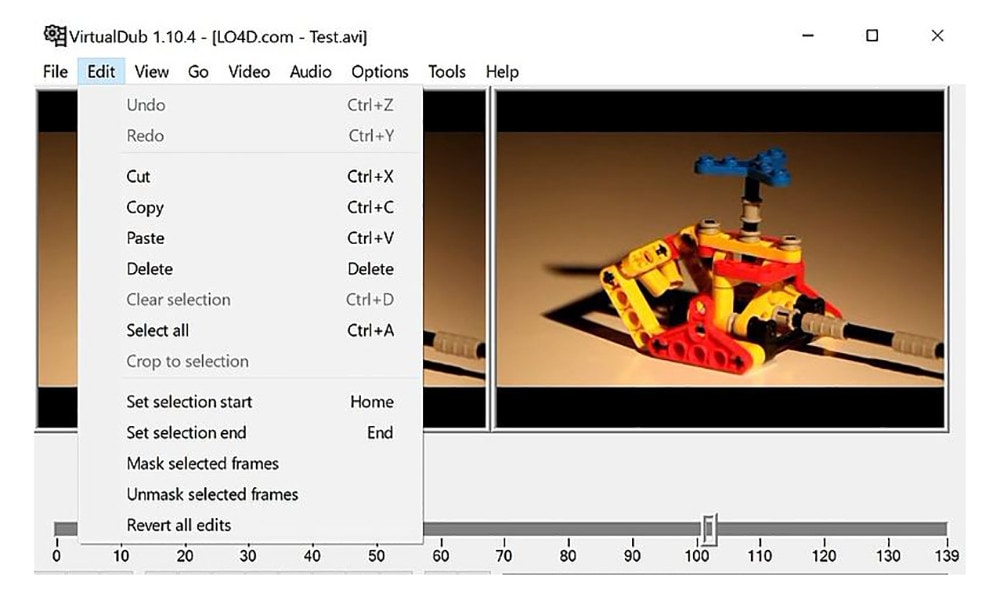
Key features
- Integrated volume and histogram meter
- Optimized disk
- Noise reduction
- Fractional frame rates
Price: Free
Pros
- Clean interface, easy to use
- Keyboard and mouse shortcuts for faster operation
- Free to use
Cons
- Not suitable for 4K editing
- Lack learning material
- Obsolete Interface
Supported OS: Windows
Compare Camp Ratings: 4.0 stars out of 5
Summary
Virtual Dub supports multitasking, and its features are pretty helpful. However, it lacks 4k editing and a friendly interface. Overall Virtual Dub is a good choice.
4. Sony Vegas Movie Studio
This video editing software makes it easy to create professional-looking videos in minimum time and effort. Vegas Movie Studio software is best for video editing professionals who have been doing it for some time and are looking for something a little more sophisticated than free alternatives. Not only does it has a high retail price, but its internal elements can be too complex for those just beginning.
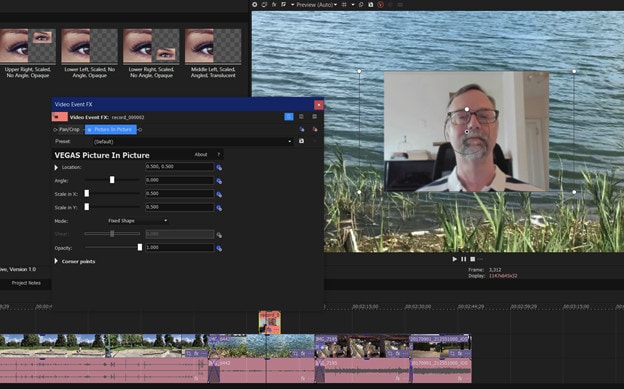
Key features
- Color correction
- HDV and AVCHD-editing
- DV batch capture
- Wide variety of file formats and codecs
Price: Starting from $7.99 USD per month
Pros
- Customizable interface
- Multicam editing
- Lots of effects and transitions, with plug-in capability
- Good slow motion and warp flow transition tools
Cons
- Less intuitive interface than competitors
- Import from camcorder not ideal
- Some tools are complex
Supported OS: Windows
G2 Ratings: 4.4 out of 5
Summary
Vegas Movie Studio is the choice of professionals. It does all the work without taking up a lot of resources, and like most programs, there is a learning curve. It’s not always intuitive for beginners, but its professional and powerful features score decent in most reviews.
5. WeVideo
This cloud-based application is a simple-to-use video editing and sharing suite. WeVideo is a full-featured video editing application that uses JumpStart technology to create amazing videos. It’s an innovative app that offers a seamless editing experience as it supports multiple formats of video, images, audio, and graphics.
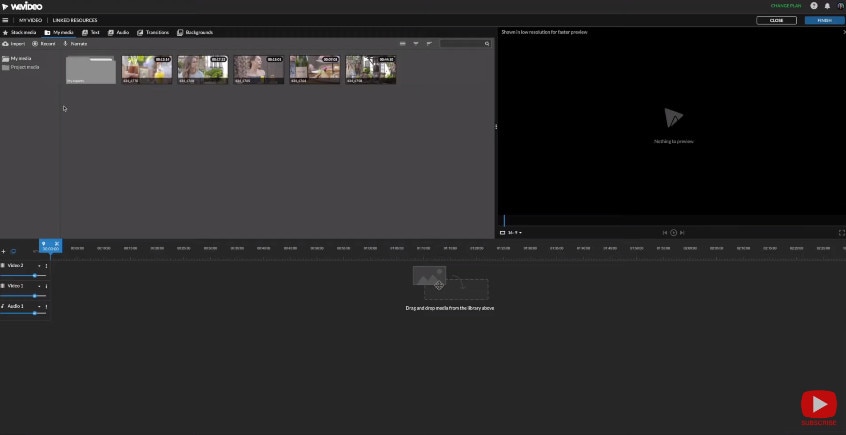
Key features
- WeVideo JumpStart
- Cloud storage
- Built-in graphics
- Customizable environment
- Advanced text editing
- Multi-track editing and storyboard
Price
- Free trial
- Power Plan: $9.99/month
- Unlimited Plan: $15.99/month
- Professional Plan: $39.99/month
- Business Plan: $73.99/month
Pros
- Constantly improving features
- Ease of use
- Storage is cloud-based
Cons
- Old fashion transition
- Leaves a watermark on free trial
Supported OS: Online
Trustpilot Ratings: 4 stars out of 5
Summary
WeVideo is a straightforward yet robust video editor. It offers a variety of features and supports multiple formats, plus its comprehensive pricing plan makes it useful for everyone.
6. Lightworks
Lightworks is the most powerful video editor in its class and an excellent tool for professionals who want to make amazing videos quickly. Lightworks is very fast and straightforward to use, and it has some great features you won’t find in any other video editor. It is available on all popular OS.
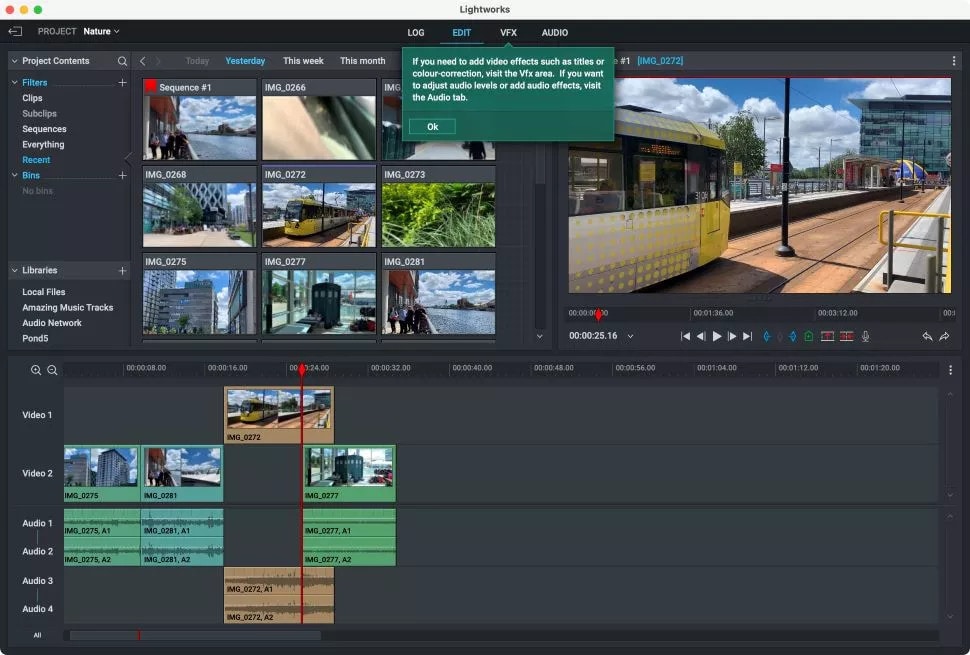
Key features
- Audio and Video Effect Plugin Support
- Cloud Connected
- Motion Graphics
- Advanced Metadata
- Proxy Workflows
- Apple ProRes decoding
Price
- Monthly Plan: $9.99/user
- Yearly Plan: $9.99/user
- Perpetual: $154.99
Pros
- High-resolution timeline rendering
- It has social media export templates
- Interfaces for multiple OS are consistent
- Instant autosave
Cons
- Commands are not always intuitive
- A bit pricey as compared to its competitors
Supported OS: Windows , Mac , Linux
Techradar Pro Ratings: 4 stars out of 5
Summary
Lightworks is not any other video editing tool available on the market of video editing tools. This video editing tool provides amateurs with the most sophisticated features in an optimized platform. Its scores are the highest on almost every review site.
7. ShotCut
Shotcut is a multiplatform video editor that lets you work with various formats for audio, video, image files, etc. This video editor makes it easy to mix and match the resolution and frame rates in a video file. All the changes you make in the editor can be undone and redone often. Shotcut is the best choice for video editing, without question.

Key features
- Webcam capture
- Audio scopes and filters
- Deinterlacing
- Eyedropper tool
- Video wipe transitions
- Keyframes for filter parameters
Price: Free
Pros
- Support for 4K resolutions
- Free
Cons
- Less intuitive than commercial apps
- Lacks built-in sharing to popular sites
Supported OS: Windows , Mac , Linux
GetApp Ratings: 4.5 out of 5 stars
Summary
Shotcut is an open-source video editor for creative professionals and is available on mac, Windows, and Linux. The free version of Shotcut has many excellent features, but it doesn’t have the slick interface or advanced techniques of the top paid editors.
8. OpenShot
An award-winning open-source video editor that creates stunning videos. OpenShot is a fast, easy-to-use, and surprisingly powerful video editor. OpenShot Video Editor allows you to work with many different types of tracks so that your edits will seem natural. OpenShot Video Editor allows you to add your custom animations or titles. The options are endless, so it all depends on your time and interest. It is available in more than 70 languages, making it ideal for all types of users.
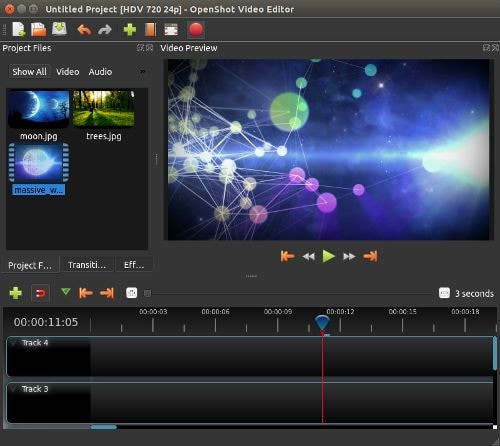
Key features
- 3D animations
- Animation and keyframes
- Multiple languages and formats
- Cross-platform
- Video-effects
Price: Free
Pros
- It is a non-linear editor with infinite tracks
- 100% free without watermark
- Frequent updates
Cons
- Obsolete interface
- Unstable performance
- Lacks some editing features
Supported OS: Window , Mac , Linux , Chrome OS
Getapp Ratings: 4.2 stars out of 5
Summary
Another open-source video-editor in the list is named OpenShot. It’s a multi-lingual and multi-supported app with unique features. Despite its unstable performance, OpenShot is still an ideal choice for many users.
9. Movavi Video Editor Plus
Movavi Video Editor Plus is the perfect tool to bring your creative ideas to life. It has special effects, ready-made intros, and keyframe animation. Using chroma keying, you can change the background of your video clips to any color or pattern that suits your need. Movavi has now redesigned its user interface to make it easy to use.
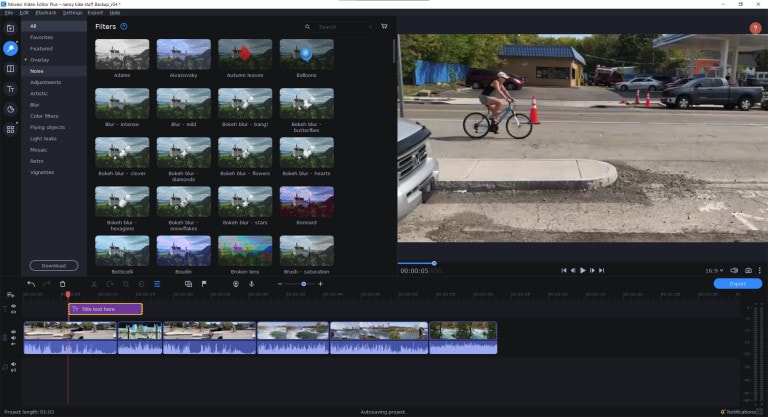
Key features
- Effects and transitions
- Built-in media pack
- Fast processing of 4K videos
- Keyframe animation
- Automatic video creation
- Cutting, trimming, joining
Price
- Free version: 7 days
- Video Editor Plus 1 year /1 PC: $49.95
- Video Editor Plus Lifetime /1 PC: $69.95
- Video Suite Lifetime /1 PC: $89.95
Pros
- Easy-to-understand user interface
- Transitions with sound
- Motion tracking and picture-in-picture tools
- Chroma-key capability
- Quick movie-creation tool
Cons
- Lacks advanced trim modes
- Slow rendering
PCMag Ratings: 4.0 stars out of 5
Summary
If you want to edit your videos with a minimal learning curve, try Movavi. You get PiP, chroma-keying, titling, basic keying, and motion tracking. The program is simple to use but doesn’t have all the features and stands four stars.
10. VSDC Free Video Editor
VSDC Free Video Editor is an online tool that lets you edit audio and video files to make your creations like movies, YouTube tutorial videos, and more. The audio and video files supported are extensive, and the software includes a codec manager. The Pro version isn’t necessary if you’re using the free edition of the software; it’s more than enough to get the job done.
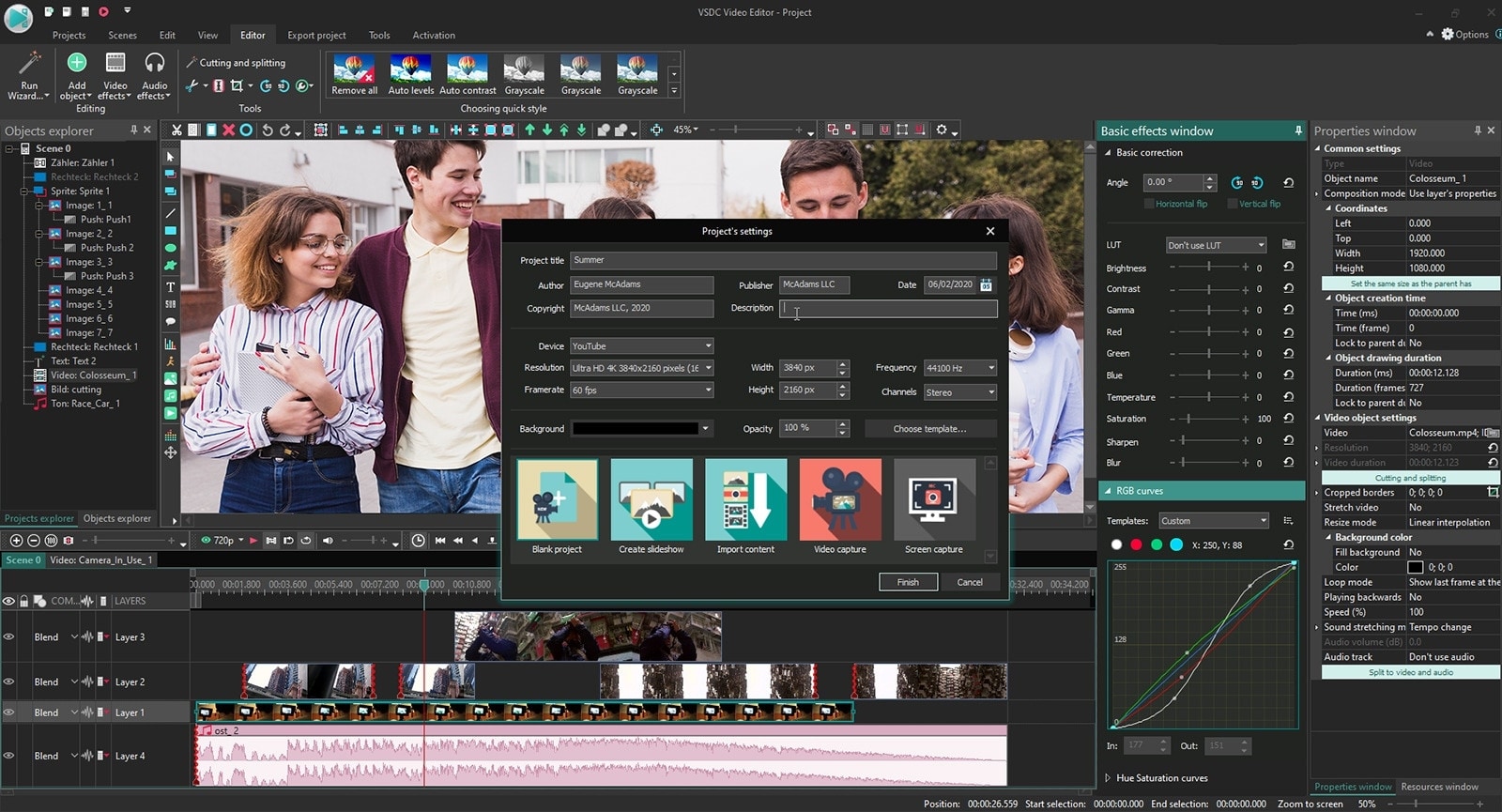
Key features
- Dark theme
- Subpixel Accuracy
- Powerful Chroma Key tool
- Trendy video effects, filters, and transitions
- Color Blending And Filters
- Built-In DVD Burning Tool
Price: Free
Pros
- Non-linear
- Video effects library
- Video stabilization
- Masking
Cons
- Outdated interface
- Lack keyboard shortcuts
- Only available on Windows
Supported OS: Windows
Capterra Ratings: 4.5 stars out 5
Summary
VSDC is a non-linear editor with extensive format support. It includes all the essential features an editor requires but with an obsolete UI. It is also ideal for many who need a powerful yet free video editor.
11. VideoPad Video Editor
VideoPad is a free video editor that can create stunning videos and perform basic editing tasks. A good video editor can help you to create videos for different social media platforms. You can make your videos look professional and polished with a few clicks and some simple editing skills. There’s nothing particularly exciting or advanced about this app; it’s simple enough for anyone new to video editing or even for seasoned editors. But the simple and easy-to-use interface makes the entire process very exciting.
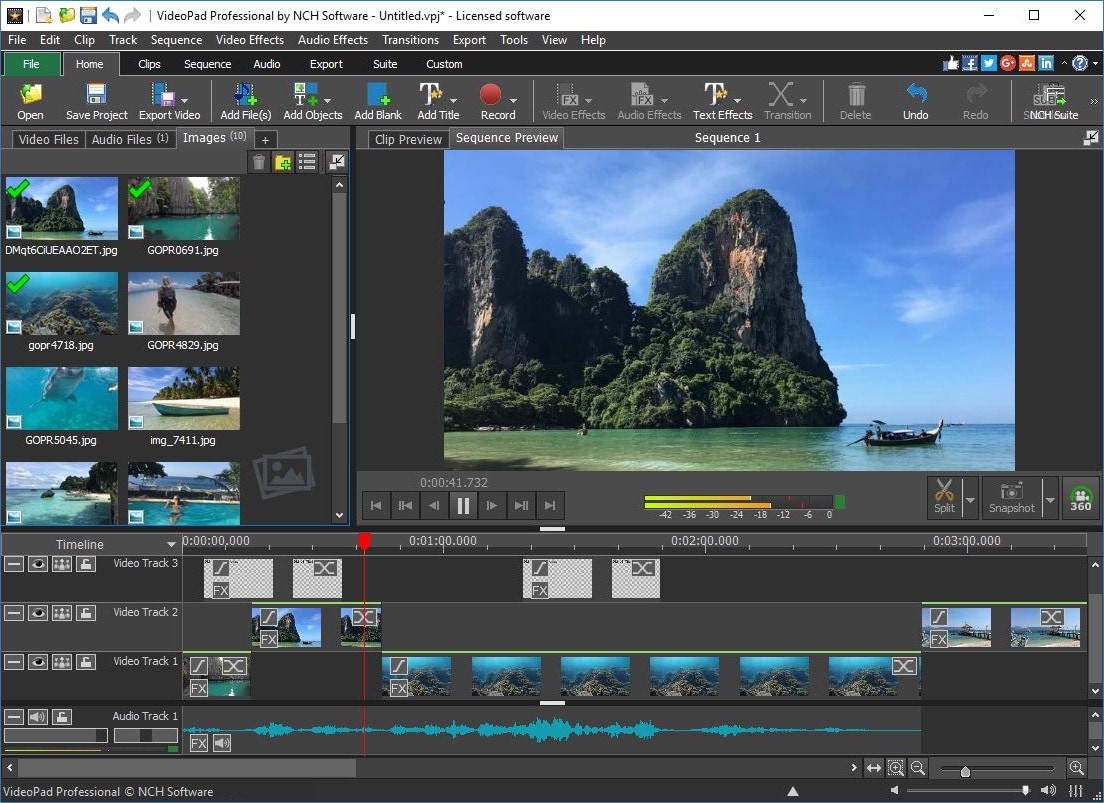
Key features
- Text snippets
- Range of transitional effects
- Plug-ins Library
- Burn finished videos to Blu-Ray, DVD, etc.
- Color correction and light balance.
Price: Free
Pros
- Simple and clean interface
- Supports multiple file formats
- Includes video effects
- Lightweight on system resources
Cons
- Lack of advanced features
Supported OS: Windows , Mac , iPad/iPhone
Tom’s guide Ratings: 3.5 stars out of 5
Summary
Video pad is a free video editor designed for beginners that is lightweight and simple. VideoPad is also great for creating quick videos for social media purposes like Youtube and Facebook. The software has a high rating, as shown above, and it’s available on Windows.
12. HitFilm
HitFilm is a helpful video editing software that makes editing easier for users. In addition to basic features, the program also provides advanced-level functions that make edited videos pop. Hitfilm Express Download has more than 400 features to help casual video editors save time. Features like: visual effects, cinematic elements, and compositing tools preset help unleash your creativity.
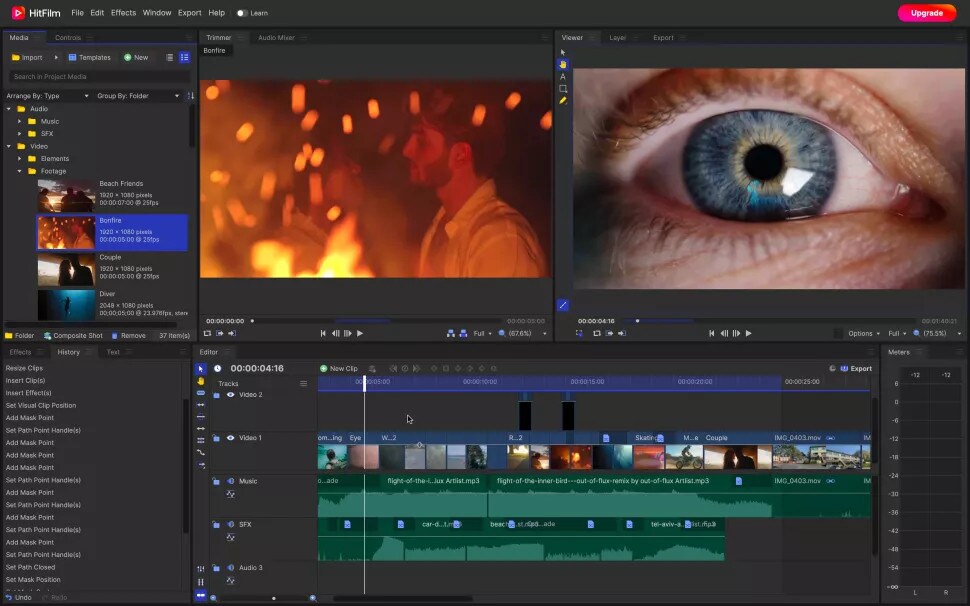
Key features
- Color Grading and correction
- Smart search
- Commentator recorder
- Lightning and lens flares
- 3D camera tracker
Price
- Free trial
- Creator: $7.50
- Pro: $12.50
- Enterprise: Custom pricing
Pros
- Intuitive interface
- It offers free tutorials and masterclasses
- Works on both Windows and Mac
Cons
- It requires heavy system requirements
TechRadar Ratings: 4.5 stars out of 5
Summary
HitFilm Express 15 is a powerful free video editing program that enables you to create high-quality videos in minutes with an intuitive interface. It offers advanced editing features such as advanced video trimming, 3D editing, and more.
13. Magix Movie Studio
Magix is the world’s leading professional audiovisual media software, with Sequoia being its industry-standard audio editing software. This movie editor is an enthusiast-level video editing software that competes with software from Adobe and CyberLink, and it even boasts support for 4K content and 360 degrees. There are many reasons to upgrade. This year’s update includes stabilization, 8K editing, motion tracking, and an in-app plug-in store.
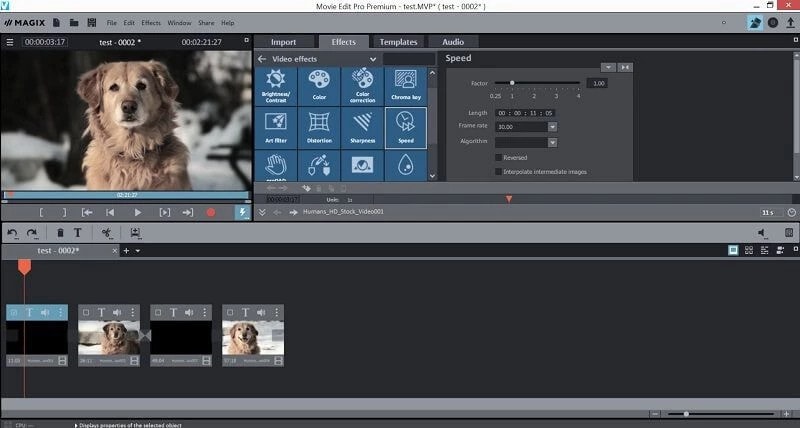
Key features
- NewBlue effects
- Fly-in animation
- New filter view
- Stabilization
- Motion tracking
- 8k support
Price
- Movie Studio 2024: $69.99 (30-day free trial)
- Movie Studio 2024 Platinum: $99.99 (30-day free trial)
- Movie Studio 2024 Suite: $129.00 (30-day free trial)
Pros
- Lots of video effects
- Responsive editing interface
- Multicam
- Trailer-like movie templates
- Solid audio editing
Cons
- Slower project rendering than others
- Lacks import and organization tools
Supported OS: Windows
PCMag Ratings: 3 stars out of 5
Summary
Magix movie studio is a powerful all-around video editing tool with many features that professional users have come to expect. It’s also relatively simple to use. But usability and performance are poor compared to other software programs like Filmora .
Part 4: How To Edit a Video With a Windows Movie Maker Alternative
Windows Movie Maker was great for editing a video, but it’s no match for some of the best video editing software. We’re talking about software capable of creating a cinematic experience in seconds, all on your computer.
When you need to edit a video with simple, quick edits, like adding a special effect or changing the background, try Filmora . Filmora is an easy-to-use application that allows you to create a movie using simple tools that don’t require additional training. You can’t beat this option if you want to create a professional-quality video for your blog or website.
Let’s dive into a quick tutorial on editing videos in Filmora:
Free Download For Win 7 or later(64-bit)
Free Download For macOS 10.14 or later
Step1 Open Wondershare Filmora on your PC or Mac
You can start a new project by clicking on ‘New Project’. And you can also change the ‘Aspect Ratio’ according to your project demand.

Step2 Import Videos
You can import your file by clicking the import tab on the upper-left side or clicking the import icon on the main window.
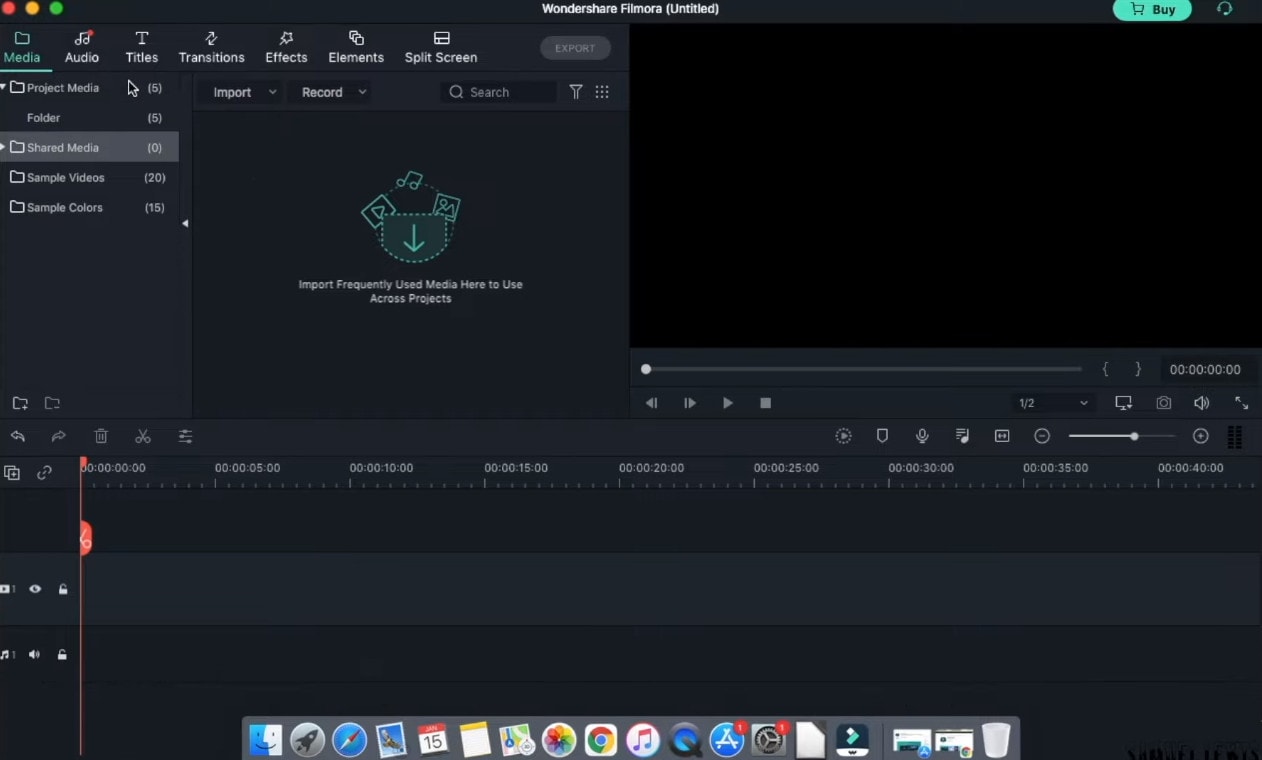
Step3 Drag and drop your footage to the timeline
After importing all the files, click and hold each individual video and drag and drop it to the timeline area according to your ideal sequence.
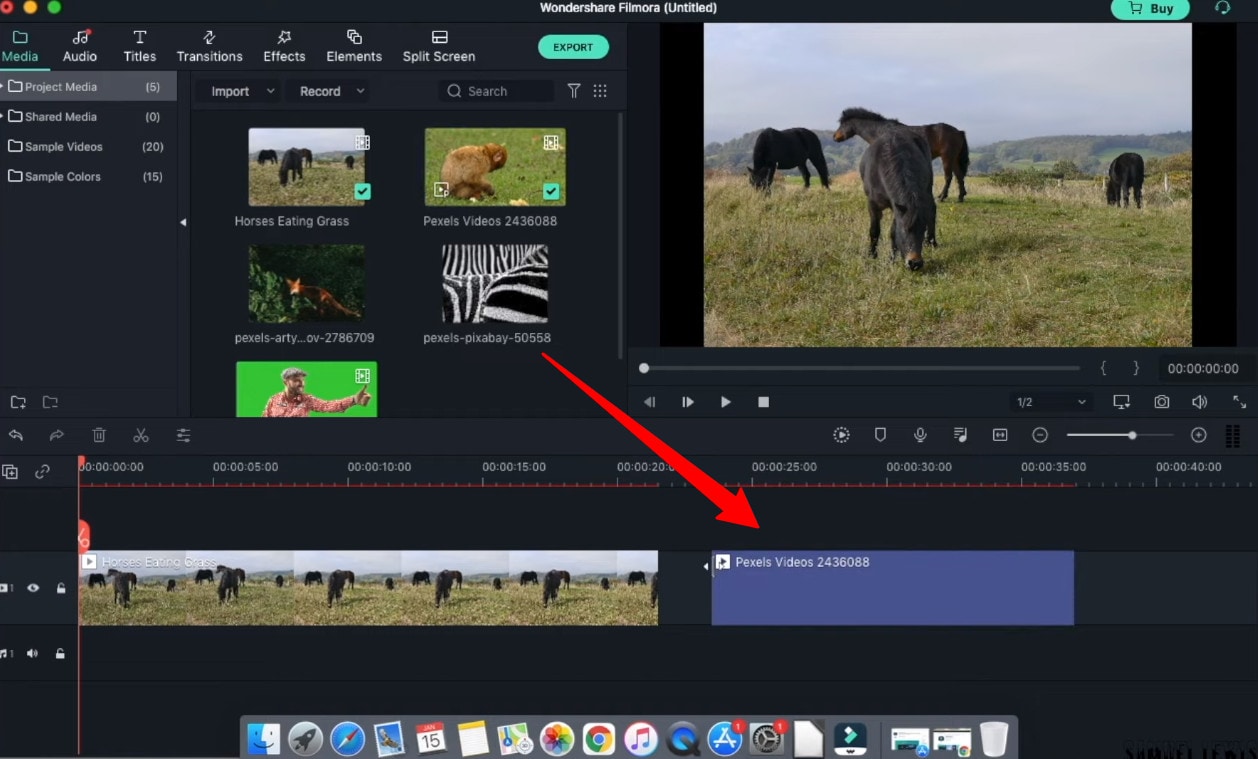
Step4 Add Audio
Go to the ‘Audio’ tab and select the audio file from the audio library. Once selected, drag and drop the audio file into the music timeline.
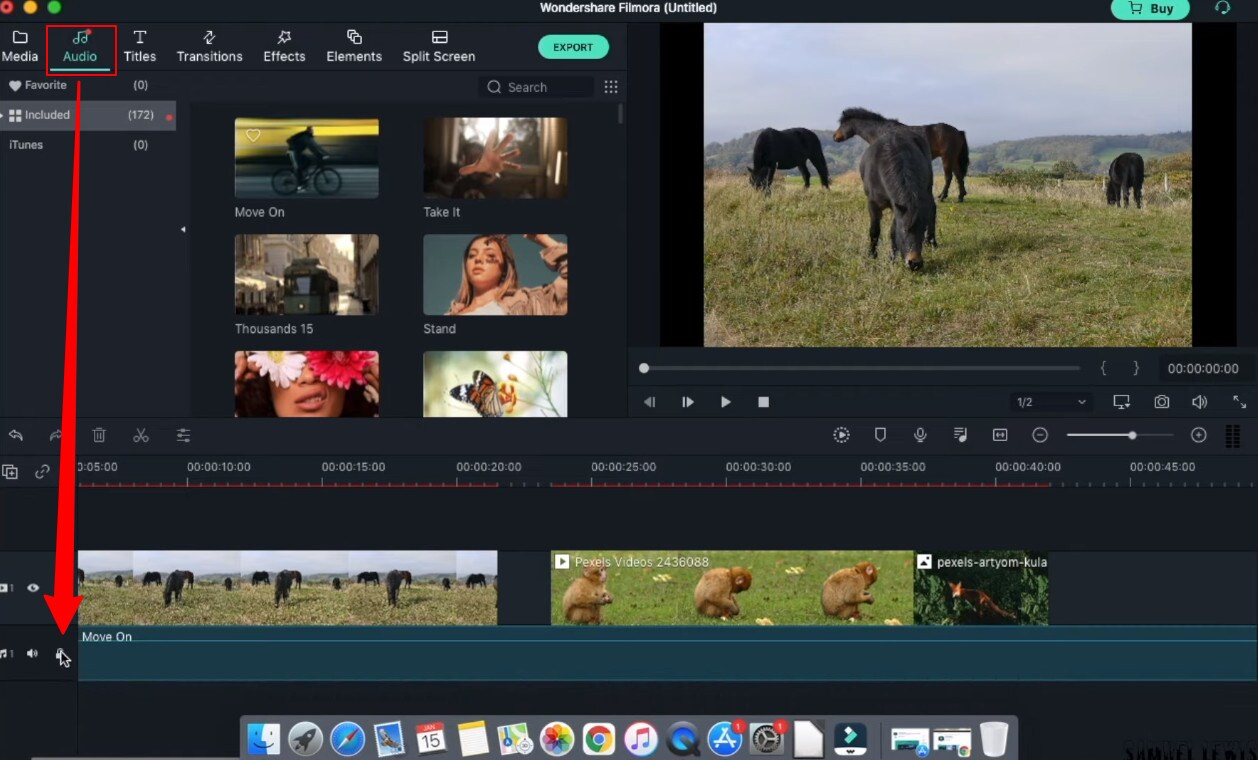
Step5 Add Titles
In your video intro, you can insert some title text. Go to the ‘Titles’ tab and select the one you like, and drag and drop it on top of the timeline. Double-click and edit the text and state your ideal statements. You can customize your text fonts and color too.
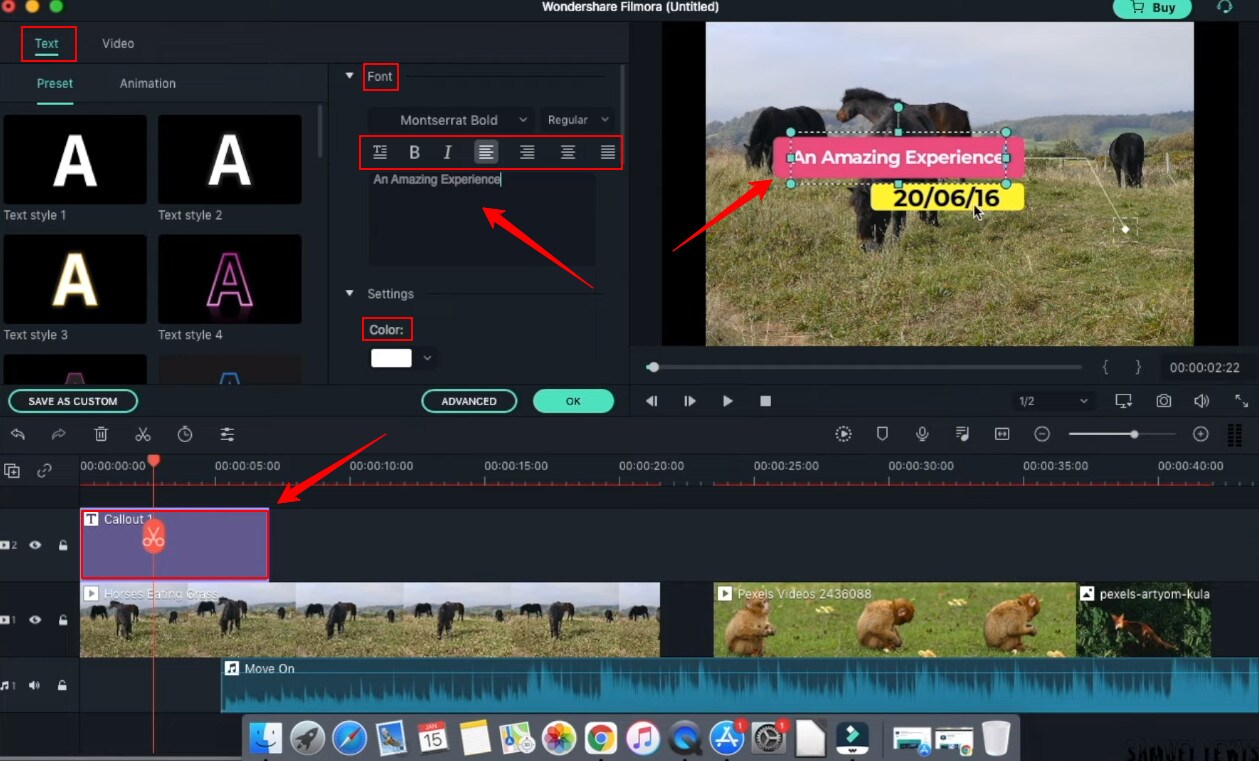
Step6 Add Transitions
You can add transition effects to ensure a smooth transition from one scene to another. The overall will get more professional look.

Step7 Add Effects
Next; you can get special effects to your video to make them more attractive and engaging to watch. Simple drag down the effect to your video and watch the effect take place in your selective scene.
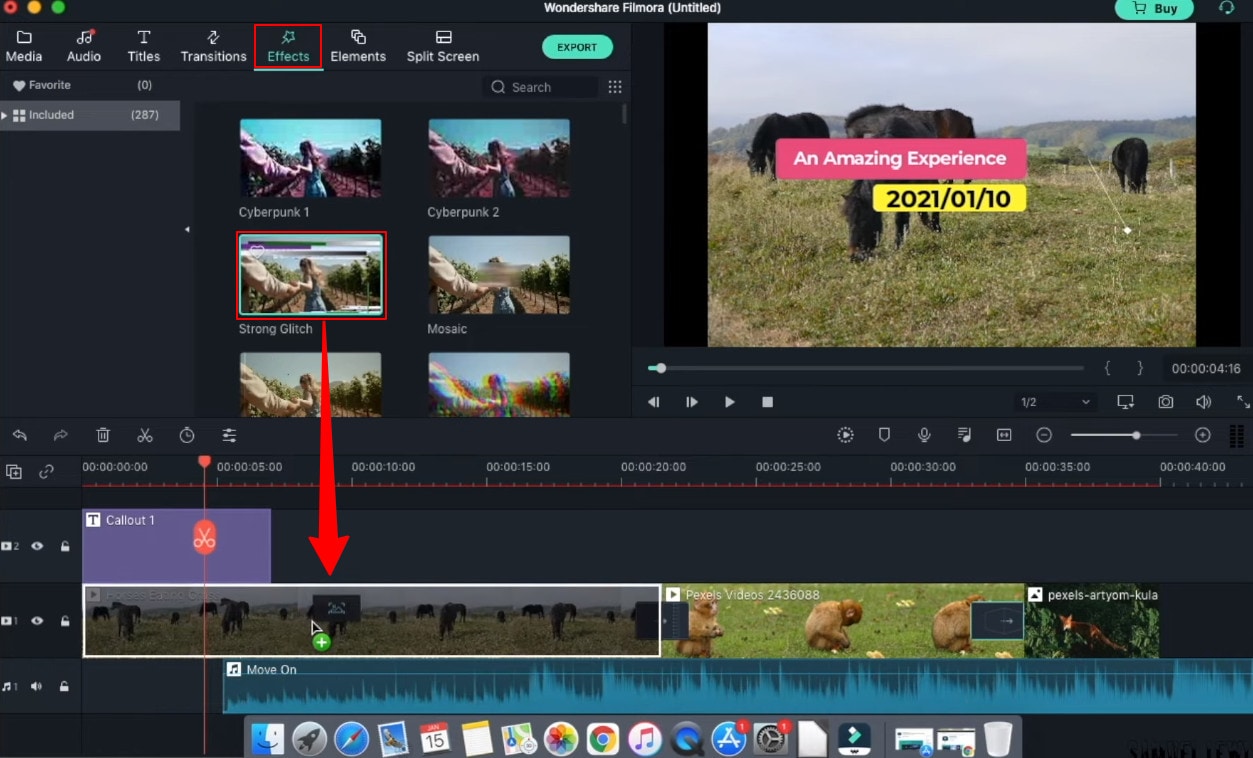
Step8 Export your work
Once all the changes have been made, hit ‘export’ from the top tab. A window will appear where you can change the settings, resolution, frame rate, bit rate, etc. Next, click the ‘export’ button down on that window, and then you can save the file in your drive.
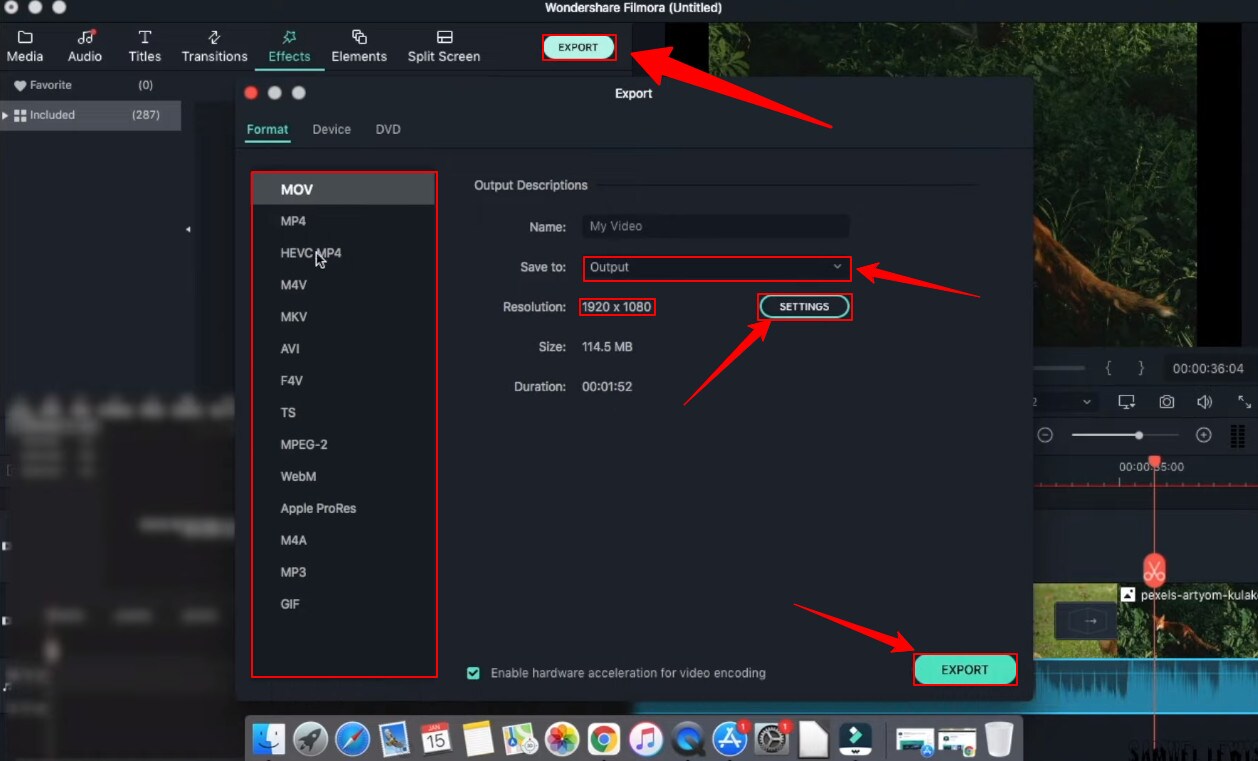
Part 5: Hot FAQs on Windows Movie Maker Alternatives
1. Why is Windows Movie Maker discontinued?
Microsoft’s video editing program, Windows Movie Maker, did not become a big hit with the public because it failed to do well on the market. Microsoft couldn’t get the support they were looking for from the program’s users. As a result, Microsoft had to cease its support of the program.
2. Is there a free version of Windows Movie Maker?
Microsoft Windows Movie maker was always accessible and pre-installed every windows product. Microsoft has discontinued support for Movie Maker and warns about free downloads of Movie Maker provided by third parties that might contain malware, viruses, or other issues.
3. What are the best free Windows Movie Maker Alternatives for Mac?
After switching to a Mac, you’ll find that the Windows Movie Maker alternatives offer much more than just a simple video editor. They provide advanced features, easy transitions, and less technical know-how to create pro-quality results. You should try using these platforms on your Mac if you have a video to edit.
- Wondershare Filmora
- Movavi
- OpenShot
Final Words
Windows Movie Maker is an excellent Windows video editor application for Windows users. But in recent years, it has become outdated due to the continuous development of new technologies. There are many alternatives for Windows Movie Maker, and here we listed some of the best ones. Most of them are free and featured packs. Each program has its unique set of features and capabilities, and each one excels in different areas. Check them out and see what you think.
Free Download For Win 7 or later(64-bit)
Free Download For macOS 10.14 or later
Part 1: Top 3 Picks for Windows Movie Maker Alternatives
The world’s best video editing software is about to change. We look at three of the most popular and valuable alternatives to Windows Movie Maker.
You will need to consider these alternatives to ensure they meet your expectations and needs.
1. Wondershare Filmora - Best Overall

Filmora is the best Windows Movie Maker Alternative designed according to your convenience.
Ratings: 4.4 Stars out 5
Starting from $49.99
2. Magix Movie Studio - Best for Collages

This alternative offers a variety of tools and plugins for anyone who wants to create professional-level videos in under a minute.
Download on Windows
Ratings: 4 stars out of 5
30-day free trials, then starts from $69.99 all the way to $129
3. Avidemux Video Editor - Best Open-Source Editor

An open-source editor that supports a wide range of formats is free! Avidemux has an interface similar to Windows Movie Maker, which makes it a perfect alternative.
Download on Windows
Ratings: 4.0 stars out of 5
Free Trial
Part 2: Ultimate Overview on 13 Best Alternatives to Windows Movie Maker
We live in visual culture, and we constantly see, capture, upload, and share videos on our smartphones, tablets, and laptops. So, it is only natural that more people seek ways to edit their videos. Windows Movie Maker was one of the most popular video editing apps. So it’s time to dig into the best Windows Movie Maker alternatives, which are arguably better and feature-rich.
| Software | OS | Media Resources | AI editing | Easy to Use | Free Trial |
|---|---|---|---|---|---|
| Wondershare Filmora | WindowsMacMobile | Yes | Yes | Yes | Yes |
| Avidemux | WindowsOS XLinuxBSD | Yes | No | Yes | Yes |
| Virtual Dub | Windows | No | No | Yes | Yes |
| Vegas Movie Studio | Windows | Yes | Yes | No | No |
| WeVideo | Online | Yes | No | Yes | Yes |
| Lightworks | LinuxOS X Windows | Yes | Yes | No | No |
| ShotCut | WindowsMacLinuxBSD | Yes | No | No | Yes |
| OpenShot | WindowsMacLinuxChrome OS | Yes | No | Yes | Yes |
| Movavi Plus | WindowsMac | Yes | No | Yes | Yes |
| VSDC | Windows | Yes | No | Yes | Yes |
| VideoPad | WindowsMaciPad/iPhone | Yes | No | Yes | Yes |
| HitFilm | WindowsMac | Yes | Yes | Yes | Yes |
| Magix Movie Studio | Windows | Yes | Yes | No | Yes |
Part 3: 13 Best Windows Movie Maker Alternatives for Windows
As we all know, Windows Movie Maker is the most used and trusted tool for creating videos in Windows. With its unique features and user-friendly interface, people often use this software to develop short and entertaining videos.
However, the fact is that Windows Movie Maker is not the current best video editing software for creating complex video projects. For this reason, we compiled a list of the 12 best alternatives to offer you a better option for Windows Movie Maker.
1. Wondershare Filmora
Filmora 11 is a powerful, easy-to-use video editor specially designed to streamline your workflow and save you hours weekly. It supports everything from Windows, Mac, and IOS to Android. The latest update to the flagship app includes several key enhancements that result in a much more efficient video creation workflow and one that’s easier to use than its rivals.

Key features
- Preset Templates
- Instant Mode
- Motion Tracking
- AI Editing Effects
- Auto Synchronization
- Plug-ins
Price
- Annual Plan: $49.99
- Perpetual Plan: $79.99
Pros
- Seamless interface for beginners
- Great customer support
- Plenty of effects and preset templates
- 4K video output options
Cons
- Rendering requires too much time
- The mobile app requires separate subscription
Supported OS: Windows , Mac , iOS , Android , iPad
G2 Ratings: 4.4 stars out of 5
Summary
Filmora’s intuitive interface allows experienced and brand-new users to create incredible videos with flawless special effects. Its high ratings and multiple supported formats make it quite popular among users.
2. Avidemux Video Editor
If you are a beginner and want to use a free, open-source software program for basic video editing, then Avidemux is a good choice. The interface is not as fancy as it could be, but there are some presets that’ll save you a lot of time. Avidemux is a cross-platform video editor that allows you to create custom videos, but it doesn’t feature the ability to share the edited footage to social media directly,

Key features
- Video and Audio Filters
- Support Popular Formats
- Convert Video For Archiving or Publishing
Price: Free
Pros
- It can convert Video To A Smaller Size
- Easy cut, trim, split video
Cons
- Out-dated UI
- Lacks sharing option
Supported OS: Windows , OS X , Linux , BSD
Uptodown Ratings: 4.0 stars out of 5
Summary
An open-source video editor that supports most formats. Due to its obsolete UI and lack of sharing features, Avidemux has average ratings.
3. VirtualDub
This open-source software is user-friendly and allows users with little experience to navigate the software without much trouble. It supports 3rd party apps and also offers batch-processing, which means working on multiple videos simultaneously makes it possible.

Key features
- Integrated volume and histogram meter
- Optimized disk
- Noise reduction
- Fractional frame rates
Price: Free
Pros
- Clean interface, easy to use
- Keyboard and mouse shortcuts for faster operation
- Free to use
Cons
- Not suitable for 4K editing
- Lack learning material
- Obsolete Interface
Supported OS: Windows
Compare Camp Ratings: 4.0 stars out of 5
Summary
Virtual Dub supports multitasking, and its features are pretty helpful. However, it lacks 4k editing and a friendly interface. Overall Virtual Dub is a good choice.
4. Sony Vegas Movie Studio
This video editing software makes it easy to create professional-looking videos in minimum time and effort. Vegas Movie Studio software is best for video editing professionals who have been doing it for some time and are looking for something a little more sophisticated than free alternatives. Not only does it has a high retail price, but its internal elements can be too complex for those just beginning.

Key features
- Color correction
- HDV and AVCHD-editing
- DV batch capture
- Wide variety of file formats and codecs
Price: Starting from $7.99 USD per month
Pros
- Customizable interface
- Multicam editing
- Lots of effects and transitions, with plug-in capability
- Good slow motion and warp flow transition tools
Cons
- Less intuitive interface than competitors
- Import from camcorder not ideal
- Some tools are complex
Supported OS: Windows
G2 Ratings: 4.4 out of 5
Summary
Vegas Movie Studio is the choice of professionals. It does all the work without taking up a lot of resources, and like most programs, there is a learning curve. It’s not always intuitive for beginners, but its professional and powerful features score decent in most reviews.
5. WeVideo
This cloud-based application is a simple-to-use video editing and sharing suite. WeVideo is a full-featured video editing application that uses JumpStart technology to create amazing videos. It’s an innovative app that offers a seamless editing experience as it supports multiple formats of video, images, audio, and graphics.

Key features
- WeVideo JumpStart
- Cloud storage
- Built-in graphics
- Customizable environment
- Advanced text editing
- Multi-track editing and storyboard
Price
- Free trial
- Power Plan: $9.99/month
- Unlimited Plan: $15.99/month
- Professional Plan: $39.99/month
- Business Plan: $73.99/month
Pros
- Constantly improving features
- Ease of use
- Storage is cloud-based
Cons
- Old fashion transition
- Leaves a watermark on free trial
Supported OS: Online
Trustpilot Ratings: 4 stars out of 5
Summary
WeVideo is a straightforward yet robust video editor. It offers a variety of features and supports multiple formats, plus its comprehensive pricing plan makes it useful for everyone.
6. Lightworks
Lightworks is the most powerful video editor in its class and an excellent tool for professionals who want to make amazing videos quickly. Lightworks is very fast and straightforward to use, and it has some great features you won’t find in any other video editor. It is available on all popular OS.

Key features
- Audio and Video Effect Plugin Support
- Cloud Connected
- Motion Graphics
- Advanced Metadata
- Proxy Workflows
- Apple ProRes decoding
Price
- Monthly Plan: $9.99/user
- Yearly Plan: $9.99/user
- Perpetual: $154.99
Pros
- High-resolution timeline rendering
- It has social media export templates
- Interfaces for multiple OS are consistent
- Instant autosave
Cons
- Commands are not always intuitive
- A bit pricey as compared to its competitors
Supported OS: Windows , Mac , Linux
Techradar Pro Ratings: 4 stars out of 5
Summary
Lightworks is not any other video editing tool available on the market of video editing tools. This video editing tool provides amateurs with the most sophisticated features in an optimized platform. Its scores are the highest on almost every review site.
7. ShotCut
Shotcut is a multiplatform video editor that lets you work with various formats for audio, video, image files, etc. This video editor makes it easy to mix and match the resolution and frame rates in a video file. All the changes you make in the editor can be undone and redone often. Shotcut is the best choice for video editing, without question.

Key features
- Webcam capture
- Audio scopes and filters
- Deinterlacing
- Eyedropper tool
- Video wipe transitions
- Keyframes for filter parameters
Price: Free
Pros
- Support for 4K resolutions
- Free
Cons
- Less intuitive than commercial apps
- Lacks built-in sharing to popular sites
Supported OS: Windows , Mac , Linux
GetApp Ratings: 4.5 out of 5 stars
Summary
Shotcut is an open-source video editor for creative professionals and is available on mac, Windows, and Linux. The free version of Shotcut has many excellent features, but it doesn’t have the slick interface or advanced techniques of the top paid editors.
8. OpenShot
An award-winning open-source video editor that creates stunning videos. OpenShot is a fast, easy-to-use, and surprisingly powerful video editor. OpenShot Video Editor allows you to work with many different types of tracks so that your edits will seem natural. OpenShot Video Editor allows you to add your custom animations or titles. The options are endless, so it all depends on your time and interest. It is available in more than 70 languages, making it ideal for all types of users.

Key features
- 3D animations
- Animation and keyframes
- Multiple languages and formats
- Cross-platform
- Video-effects
Price: Free
Pros
- It is a non-linear editor with infinite tracks
- 100% free without watermark
- Frequent updates
Cons
- Obsolete interface
- Unstable performance
- Lacks some editing features
Supported OS: Window , Mac , Linux , Chrome OS
Getapp Ratings: 4.2 stars out of 5
Summary
Another open-source video-editor in the list is named OpenShot. It’s a multi-lingual and multi-supported app with unique features. Despite its unstable performance, OpenShot is still an ideal choice for many users.
9. Movavi Video Editor Plus
Movavi Video Editor Plus is the perfect tool to bring your creative ideas to life. It has special effects, ready-made intros, and keyframe animation. Using chroma keying, you can change the background of your video clips to any color or pattern that suits your need. Movavi has now redesigned its user interface to make it easy to use.

Key features
- Effects and transitions
- Built-in media pack
- Fast processing of 4K videos
- Keyframe animation
- Automatic video creation
- Cutting, trimming, joining
Price
- Free version: 7 days
- Video Editor Plus 1 year /1 PC: $49.95
- Video Editor Plus Lifetime /1 PC: $69.95
- Video Suite Lifetime /1 PC: $89.95
Pros
- Easy-to-understand user interface
- Transitions with sound
- Motion tracking and picture-in-picture tools
- Chroma-key capability
- Quick movie-creation tool
Cons
- Lacks advanced trim modes
- Slow rendering
PCMag Ratings: 4.0 stars out of 5
Summary
If you want to edit your videos with a minimal learning curve, try Movavi. You get PiP, chroma-keying, titling, basic keying, and motion tracking. The program is simple to use but doesn’t have all the features and stands four stars.
10. VSDC Free Video Editor
VSDC Free Video Editor is an online tool that lets you edit audio and video files to make your creations like movies, YouTube tutorial videos, and more. The audio and video files supported are extensive, and the software includes a codec manager. The Pro version isn’t necessary if you’re using the free edition of the software; it’s more than enough to get the job done.

Key features
- Dark theme
- Subpixel Accuracy
- Powerful Chroma Key tool
- Trendy video effects, filters, and transitions
- Color Blending And Filters
- Built-In DVD Burning Tool
Price: Free
Pros
- Non-linear
- Video effects library
- Video stabilization
- Masking
Cons
- Outdated interface
- Lack keyboard shortcuts
- Only available on Windows
Supported OS: Windows
Capterra Ratings: 4.5 stars out 5
Summary
VSDC is a non-linear editor with extensive format support. It includes all the essential features an editor requires but with an obsolete UI. It is also ideal for many who need a powerful yet free video editor.
11. VideoPad Video Editor
VideoPad is a free video editor that can create stunning videos and perform basic editing tasks. A good video editor can help you to create videos for different social media platforms. You can make your videos look professional and polished with a few clicks and some simple editing skills. There’s nothing particularly exciting or advanced about this app; it’s simple enough for anyone new to video editing or even for seasoned editors. But the simple and easy-to-use interface makes the entire process very exciting.

Key features
- Text snippets
- Range of transitional effects
- Plug-ins Library
- Burn finished videos to Blu-Ray, DVD, etc.
- Color correction and light balance.
Price: Free
Pros
- Simple and clean interface
- Supports multiple file formats
- Includes video effects
- Lightweight on system resources
Cons
- Lack of advanced features
Supported OS: Windows , Mac , iPad/iPhone
Tom’s guide Ratings: 3.5 stars out of 5
Summary
Video pad is a free video editor designed for beginners that is lightweight and simple. VideoPad is also great for creating quick videos for social media purposes like Youtube and Facebook. The software has a high rating, as shown above, and it’s available on Windows.
12. HitFilm
HitFilm is a helpful video editing software that makes editing easier for users. In addition to basic features, the program also provides advanced-level functions that make edited videos pop. Hitfilm Express Download has more than 400 features to help casual video editors save time. Features like: visual effects, cinematic elements, and compositing tools preset help unleash your creativity.

Key features
- Color Grading and correction
- Smart search
- Commentator recorder
- Lightning and lens flares
- 3D camera tracker
Price
- Free trial
- Creator: $7.50
- Pro: $12.50
- Enterprise: Custom pricing
Pros
- Intuitive interface
- It offers free tutorials and masterclasses
- Works on both Windows and Mac
Cons
- It requires heavy system requirements
TechRadar Ratings: 4.5 stars out of 5
Summary
HitFilm Express 15 is a powerful free video editing program that enables you to create high-quality videos in minutes with an intuitive interface. It offers advanced editing features such as advanced video trimming, 3D editing, and more.
13. Magix Movie Studio
Magix is the world’s leading professional audiovisual media software, with Sequoia being its industry-standard audio editing software. This movie editor is an enthusiast-level video editing software that competes with software from Adobe and CyberLink, and it even boasts support for 4K content and 360 degrees. There are many reasons to upgrade. This year’s update includes stabilization, 8K editing, motion tracking, and an in-app plug-in store.

Key features
- NewBlue effects
- Fly-in animation
- New filter view
- Stabilization
- Motion tracking
- 8k support
Price
- Movie Studio 2024: $69.99 (30-day free trial)
- Movie Studio 2024 Platinum: $99.99 (30-day free trial)
- Movie Studio 2024 Suite: $129.00 (30-day free trial)
Pros
- Lots of video effects
- Responsive editing interface
- Multicam
- Trailer-like movie templates
- Solid audio editing
Cons
- Slower project rendering than others
- Lacks import and organization tools
Supported OS: Windows
PCMag Ratings: 3 stars out of 5
Summary
Magix movie studio is a powerful all-around video editing tool with many features that professional users have come to expect. It’s also relatively simple to use. But usability and performance are poor compared to other software programs like Filmora .
Part 4: How To Edit a Video With a Windows Movie Maker Alternative
Windows Movie Maker was great for editing a video, but it’s no match for some of the best video editing software. We’re talking about software capable of creating a cinematic experience in seconds, all on your computer.
When you need to edit a video with simple, quick edits, like adding a special effect or changing the background, try Filmora . Filmora is an easy-to-use application that allows you to create a movie using simple tools that don’t require additional training. You can’t beat this option if you want to create a professional-quality video for your blog or website.
Let’s dive into a quick tutorial on editing videos in Filmora:
Free Download For Win 7 or later(64-bit)
Free Download For macOS 10.14 or later
Step1 Open Wondershare Filmora on your PC or Mac
You can start a new project by clicking on ‘New Project’. And you can also change the ‘Aspect Ratio’ according to your project demand.

Step2 Import Videos
You can import your file by clicking the import tab on the upper-left side or clicking the import icon on the main window.

Step3 Drag and drop your footage to the timeline
After importing all the files, click and hold each individual video and drag and drop it to the timeline area according to your ideal sequence.

Step4 Add Audio
Go to the ‘Audio’ tab and select the audio file from the audio library. Once selected, drag and drop the audio file into the music timeline.

Step5 Add Titles
In your video intro, you can insert some title text. Go to the ‘Titles’ tab and select the one you like, and drag and drop it on top of the timeline. Double-click and edit the text and state your ideal statements. You can customize your text fonts and color too.

Step6 Add Transitions
You can add transition effects to ensure a smooth transition from one scene to another. The overall will get more professional look.

Step7 Add Effects
Next; you can get special effects to your video to make them more attractive and engaging to watch. Simple drag down the effect to your video and watch the effect take place in your selective scene.

Step8 Export your work
Once all the changes have been made, hit ‘export’ from the top tab. A window will appear where you can change the settings, resolution, frame rate, bit rate, etc. Next, click the ‘export’ button down on that window, and then you can save the file in your drive.

Part 5: Hot FAQs on Windows Movie Maker Alternatives
1. Why is Windows Movie Maker discontinued?
Microsoft’s video editing program, Windows Movie Maker, did not become a big hit with the public because it failed to do well on the market. Microsoft couldn’t get the support they were looking for from the program’s users. As a result, Microsoft had to cease its support of the program.
2. Is there a free version of Windows Movie Maker?
Microsoft Windows Movie maker was always accessible and pre-installed every windows product. Microsoft has discontinued support for Movie Maker and warns about free downloads of Movie Maker provided by third parties that might contain malware, viruses, or other issues.
3. What are the best free Windows Movie Maker Alternatives for Mac?
After switching to a Mac, you’ll find that the Windows Movie Maker alternatives offer much more than just a simple video editor. They provide advanced features, easy transitions, and less technical know-how to create pro-quality results. You should try using these platforms on your Mac if you have a video to edit.
- Wondershare Filmora
- Movavi
- OpenShot
Final Words
Windows Movie Maker is an excellent Windows video editor application for Windows users. But in recent years, it has become outdated due to the continuous development of new technologies. There are many alternatives for Windows Movie Maker, and here we listed some of the best ones. Most of them are free and featured packs. Each program has its unique set of features and capabilities, and each one excels in different areas. Check them out and see what you think.
Free Download For Win 7 or later(64-bit)
Free Download For macOS 10.14 or later
GIF Tempo Tweakers: Online, iOS, and Android Options
Top 10 Best GIF Speed Changers

Shanoon Cox
Mar 27, 2024• Proven solutions
The world is shifting, with more and more businesses and companies using online imagery and video content as a means of reaching their target audience and demographic wherever they may be - and GIF’s represent one of the biggest growing trends of the decade.
But not all GIF’s are perfect. Some react far too quickly, while some are very slow and clunky in their movement – with video editors and animators finding that simply changing the speed of a GIF can have a huge impact on the way it is viewed and used by consumers.
Part 1: Best GIF Speed Changer Software: Wondershare Filmora
If you are looking for a gif editor that empowers you to create gifs better, you should try some desktop tools. Here I recommend you using Filmora to change gif speed and edit further.
Wondershare Filmora is an easy-to-use video editor for all creators. With its user-friendly interface, a wide range of editing tools, and tons of video effects, you can create videos and change the speed of gifs easily.
How To Change GIF Speed In Filmora Video Editor?
Below is a brief step by step tutorial about changing the speed of gif with Filmora. Click to get more details about how to convert and edit gifs with Filmora.
- With your gifs open on the screen, right click and select Speed and Duration .
- In the Custom Speed window, you will see a speed slider locates at the middle, which indicates the default 1.x speed. And the Duration option suggests the duration of the gif.
- To change the speed of gif, you can drag the speed slider forward or backward to speed up or slow down the playback. Or, you can just enter the number to a specific duration.
- With such an easy process for changing the GIF speed, users will find they can adjust the clip to their hearts content, until they achieve the perfect finish.
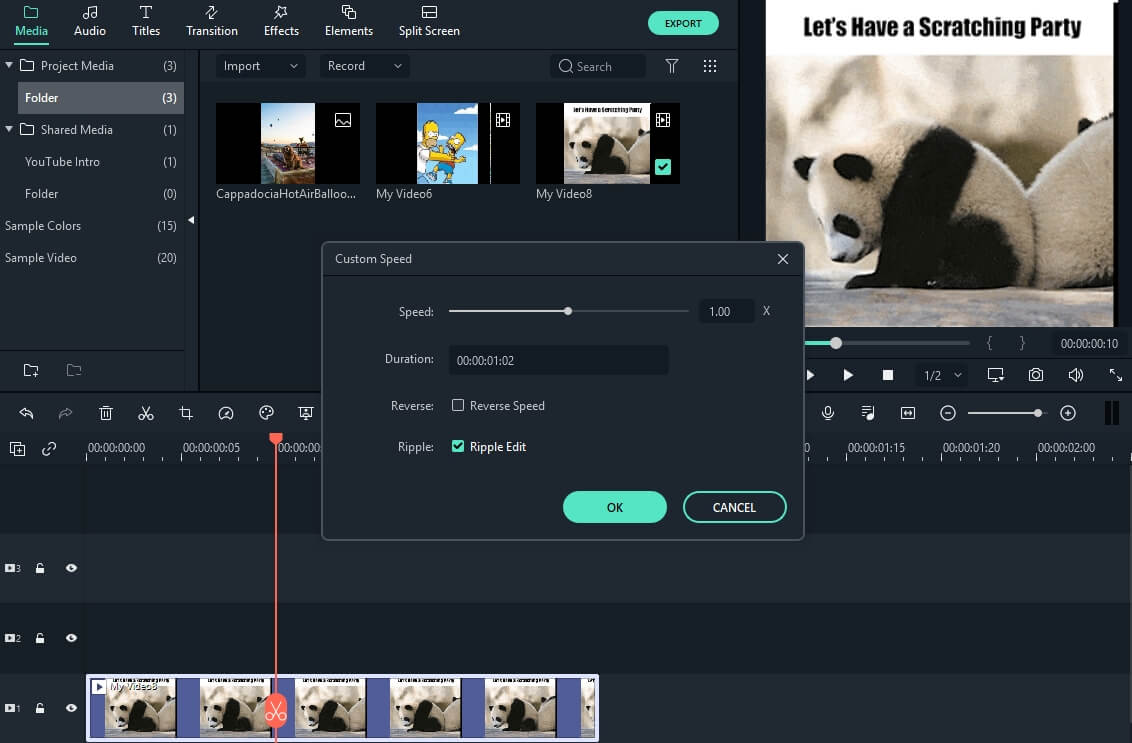
Part 2: Best Free GIF Speed Changers That Can Be Found Online
There are a few GIF speed changers which can be found online, free of charge, with varying levels of effectiveness and ease of usability dependent on the device you are using to create your GIF.
1. EZGIF.com
This online GIF speed editor offers all the usability of a basic Windows image or video editing program, but with all the technological expertise of a modern video editor. GIF’s can be edited as GIF’s or as MP4 files, and though the site takes a while to download the completed files, the end result is high in quality and creates a seamless pattern of movement. Other features include:
- No registration is required and there is no user limit – this really is a free editing site
- Colour editing and text overlay can be instantly added to any GIF footage

To change the speed of your GIF using EzGIF, visit this page https://ezgif.com/speed .
Once your GIF is uploaded to the free-to-use site, you can alter the percentage of current speed using a basic drop down – something which should always be altered based on the idea of 100% representing the original speed. Changing the percentage to 200% will make the GIF run 2x faster, and so on.
2. Veed.io
This site, found at https://www.veed.io/tools/gif-speed-changer is a great way of editing your GIF speed quickly and easily – using just a few basic steps. Once users have arrived on the site and clicked on the big blue ‘Get Started’ button, they will find themselves faced with a very simple upload tool.

From there the size, speed and colouring can be altered on their GIF, with the ability to add music also available. Changing the speed can be done using a selection of pre-programmed buttons – ranging from 0.5x (half the original speed) up to 2x (double the original speed). Users can also select the custom speed button and play around with a speed of their own making.
3. Lunapic

What we like about Lunapic is the way that the site allows us to change not only the GIF speed but also the order in which different images and visuals are presented – giving the user a chance to upload new content to add into their GIF or else simply adjust the speed and timing delay on the original clip. Users can add animation to certain aspects and parts of the video or image and can set the looping option of their GIF to start and end at any point – altering the way the end consumer views the starting image. The speeds included on the site may be determined in advance giving you a limited choice, but the range available means this isn’t too much of a problem.
4. GifGit

Cheesy website names aside, this online tool is super easy to use with a very basic user interface. Found through this site - https://www.gifgit.com/gif/edit - editing GIF’s is a simple case of uploading the GIF clip and using the Delay tool as a way of setting the speed using the delay of milliseconds on each frame. This number, in the example sitting at 80, refers to the number of milliseconds that will be spent on each frame of the GIF – with a lower number enabling the GIF to move faster while a larger delay number will make your GIF play much slower.
This site is good if you’re happy to experiment with a little trial and error!
5. IMG Flip
As with many online tools, this site does come with limitations – however, in our opinion the vast range of customisable options and editing features outweigh the fact that your GIF’s can only be stored up to 4MB before you have to start paying. For the most part, this is a site which is ideal for those who are simply looking to edit one or two GIF’s – if you’re looking to make a habit of it, then you would be best looking at one of the other sites which offers more in terms of storage and free uses.
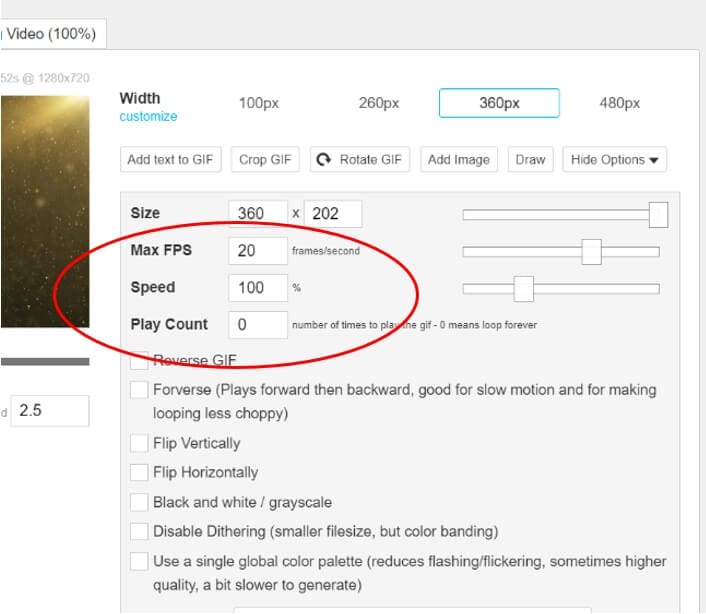
Get familiar with IMG Flip through this link - https://imgflip.com/gif-maker - and spend some time working through the different options available. To change the speed you simply need upload your clip and then adjust the speed as a percentage of the original clip – 100% being the starting point, with 200% running the GIF at twice the speed and 50% running it at half speed.
Part 3: Best GIF Speed Changers for iOS And Android
There is little that can’t be done on a smartphone in today’s world. Our phones are what we have with us at all times, and so it follows that any kind of editing we hope to do should be achievable using these portable devices – after all, modern smartphones are now fitted with cameras which surpass the capability of even some of the most expensive cameras on the market. So, which are the best GIF speed changers for phones?
1. GIF Maker - ImgPlay

We start with a simple one which can be found on the app store using any search for a GIF app. This particular app plays on the concept of building your own memes, giving users a chance to enhance their own comic value on platforms like WhatsApp and Facebook using their own images or multiple GIF’s strung together. We particularly love the fact that ImgPlay’s platform allows users to add their own text and emojis over the top of the visuals, completely personalising the end product and creating something which is unique for their own use. A simple slider tool allows for easy editing of the GIF speed, presenting an all-round great tool for beginners and experience GIF makers alike.
2. Imgur – Funny Meme and GIF Maker
Available for both Android and iOS users

The Imgur app is one of the most popular GIF creation tools out there – offering users with a platform which allows them edit as many GIFs as they like, play with the speed of existing and new GIFs, and share their creations with other users who can share your designs and help you go viral. As much an online community as a GIF editing tool, Imgur could well be the new Instagram – if Instagram suddenly decided to wave goodbye to the influencers and adverts and make way for user built content and humorous motion videos instead!
3. GIF Camera
Exclusive to Android

This is a tool which supports the creation of GIFs using actions and movements which you capture on camera straight into the app. Opening the app, you simply select the camera feature and capture the movement or motion – before diving into the editing of speed, colour, appearance and overlays. A great tool which is instant to use and allows you to create funny and more serious GIFs depending on the movement you capture.
4. Gifx
Launched as an iPhone tool
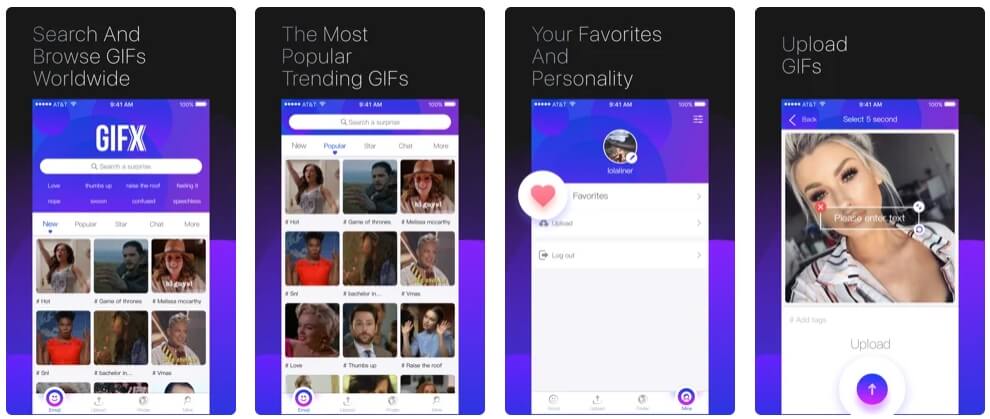
This platform is designed to allow users to edit and add to existing GIFs which they may want to adjust, add filters to and overlay with music. As with many of the other portable device tools created for Android and iPhone, the main features of this app are its user friendly interface and the fact that all GIFs created can be downloaded directly to the phone or uploaded straight to social media – depending on how the user intends to use their GIF.
5. GIF Studio
Finally, an Android tool.
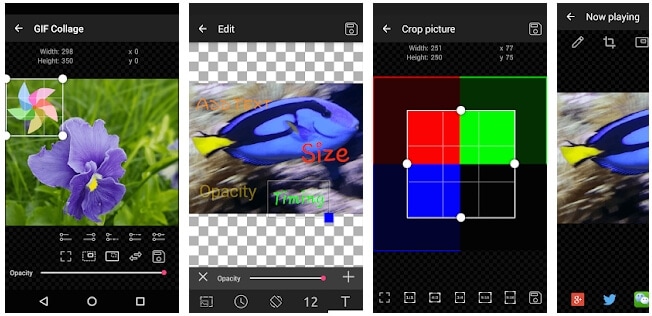
One of the fastest tools both to understand and to use, GIF studio really lets you feel like you are in a proper video editing studio – even when using the limited screen size of your phone. Users can edit the speed on existing GIFs or can create new collages with multiple GIFs, benefitting from added animation and colour and visual effects without losing the quality of the original imagery or footage.
GIF Speed Changer FAQ
Can I slow down a GIF?
In short, yes. How you do this will depend on the platform you use, however for the most part, any platform which allows the GIF to be sped up will also allow you to slow it down.
How do you change the speed of a GIF in PowerPoint?
Unfortunately, there is no tool within PowerPoint that allows users to adjust the speed of an external GIF. The small animations and movements of images and words created and controlled within PowerPoint can be adjusted in the settings of each animation tool – however, at present, GIFs themselves are unable to be altered in PowerPoint itself.
How do you make a GIF 30fps?
This number refers to the frame control time, with most computer displays running at around 60fps. To adjust this number to 30fps, the user will need to enter the settings of the GIF and set the run time at 30 for a delay of 0.03 seconds on each frame.
Why is frame rate important in GIF animation and how do you change frame rate in GIF exportation?
Frame rate comes into play when watching back the GIF as a piece of complete footage – with frame rate affecting the overall smooth transition of the GIF from frame to frame and back to the beginning. If your frame rate isn’t controlled, the finish will be jumpy and won’t look good. When you move to convert and export your GIF, you will have an option to adjust the loop setting and timeline setting – as well as the frames per second. Setting this at 30 will provide you with a seamless and consistently high quality finish – perfect for your brand new GIF.

Shanoon Cox
Shanoon Cox is a writer and a lover of all things video.
Follow @Shanoon Cox
Shanoon Cox
Mar 27, 2024• Proven solutions
The world is shifting, with more and more businesses and companies using online imagery and video content as a means of reaching their target audience and demographic wherever they may be - and GIF’s represent one of the biggest growing trends of the decade.
But not all GIF’s are perfect. Some react far too quickly, while some are very slow and clunky in their movement – with video editors and animators finding that simply changing the speed of a GIF can have a huge impact on the way it is viewed and used by consumers.
Part 1: Best GIF Speed Changer Software: Wondershare Filmora
If you are looking for a gif editor that empowers you to create gifs better, you should try some desktop tools. Here I recommend you using Filmora to change gif speed and edit further.
Wondershare Filmora is an easy-to-use video editor for all creators. With its user-friendly interface, a wide range of editing tools, and tons of video effects, you can create videos and change the speed of gifs easily.
How To Change GIF Speed In Filmora Video Editor?
Below is a brief step by step tutorial about changing the speed of gif with Filmora. Click to get more details about how to convert and edit gifs with Filmora.
- With your gifs open on the screen, right click and select Speed and Duration .
- In the Custom Speed window, you will see a speed slider locates at the middle, which indicates the default 1.x speed. And the Duration option suggests the duration of the gif.
- To change the speed of gif, you can drag the speed slider forward or backward to speed up or slow down the playback. Or, you can just enter the number to a specific duration.
- With such an easy process for changing the GIF speed, users will find they can adjust the clip to their hearts content, until they achieve the perfect finish.

Part 2: Best Free GIF Speed Changers That Can Be Found Online
There are a few GIF speed changers which can be found online, free of charge, with varying levels of effectiveness and ease of usability dependent on the device you are using to create your GIF.
1. EZGIF.com
This online GIF speed editor offers all the usability of a basic Windows image or video editing program, but with all the technological expertise of a modern video editor. GIF’s can be edited as GIF’s or as MP4 files, and though the site takes a while to download the completed files, the end result is high in quality and creates a seamless pattern of movement. Other features include:
- No registration is required and there is no user limit – this really is a free editing site
- Colour editing and text overlay can be instantly added to any GIF footage

To change the speed of your GIF using EzGIF, visit this page https://ezgif.com/speed .
Once your GIF is uploaded to the free-to-use site, you can alter the percentage of current speed using a basic drop down – something which should always be altered based on the idea of 100% representing the original speed. Changing the percentage to 200% will make the GIF run 2x faster, and so on.
2. Veed.io
This site, found at https://www.veed.io/tools/gif-speed-changer is a great way of editing your GIF speed quickly and easily – using just a few basic steps. Once users have arrived on the site and clicked on the big blue ‘Get Started’ button, they will find themselves faced with a very simple upload tool.

From there the size, speed and colouring can be altered on their GIF, with the ability to add music also available. Changing the speed can be done using a selection of pre-programmed buttons – ranging from 0.5x (half the original speed) up to 2x (double the original speed). Users can also select the custom speed button and play around with a speed of their own making.
3. Lunapic

What we like about Lunapic is the way that the site allows us to change not only the GIF speed but also the order in which different images and visuals are presented – giving the user a chance to upload new content to add into their GIF or else simply adjust the speed and timing delay on the original clip. Users can add animation to certain aspects and parts of the video or image and can set the looping option of their GIF to start and end at any point – altering the way the end consumer views the starting image. The speeds included on the site may be determined in advance giving you a limited choice, but the range available means this isn’t too much of a problem.
4. GifGit

Cheesy website names aside, this online tool is super easy to use with a very basic user interface. Found through this site - https://www.gifgit.com/gif/edit - editing GIF’s is a simple case of uploading the GIF clip and using the Delay tool as a way of setting the speed using the delay of milliseconds on each frame. This number, in the example sitting at 80, refers to the number of milliseconds that will be spent on each frame of the GIF – with a lower number enabling the GIF to move faster while a larger delay number will make your GIF play much slower.
This site is good if you’re happy to experiment with a little trial and error!
5. IMG Flip
As with many online tools, this site does come with limitations – however, in our opinion the vast range of customisable options and editing features outweigh the fact that your GIF’s can only be stored up to 4MB before you have to start paying. For the most part, this is a site which is ideal for those who are simply looking to edit one or two GIF’s – if you’re looking to make a habit of it, then you would be best looking at one of the other sites which offers more in terms of storage and free uses.

Get familiar with IMG Flip through this link - https://imgflip.com/gif-maker - and spend some time working through the different options available. To change the speed you simply need upload your clip and then adjust the speed as a percentage of the original clip – 100% being the starting point, with 200% running the GIF at twice the speed and 50% running it at half speed.
Part 3: Best GIF Speed Changers for iOS And Android
There is little that can’t be done on a smartphone in today’s world. Our phones are what we have with us at all times, and so it follows that any kind of editing we hope to do should be achievable using these portable devices – after all, modern smartphones are now fitted with cameras which surpass the capability of even some of the most expensive cameras on the market. So, which are the best GIF speed changers for phones?
1. GIF Maker - ImgPlay

We start with a simple one which can be found on the app store using any search for a GIF app. This particular app plays on the concept of building your own memes, giving users a chance to enhance their own comic value on platforms like WhatsApp and Facebook using their own images or multiple GIF’s strung together. We particularly love the fact that ImgPlay’s platform allows users to add their own text and emojis over the top of the visuals, completely personalising the end product and creating something which is unique for their own use. A simple slider tool allows for easy editing of the GIF speed, presenting an all-round great tool for beginners and experience GIF makers alike.
2. Imgur – Funny Meme and GIF Maker
Available for both Android and iOS users

The Imgur app is one of the most popular GIF creation tools out there – offering users with a platform which allows them edit as many GIFs as they like, play with the speed of existing and new GIFs, and share their creations with other users who can share your designs and help you go viral. As much an online community as a GIF editing tool, Imgur could well be the new Instagram – if Instagram suddenly decided to wave goodbye to the influencers and adverts and make way for user built content and humorous motion videos instead!
3. GIF Camera
Exclusive to Android

This is a tool which supports the creation of GIFs using actions and movements which you capture on camera straight into the app. Opening the app, you simply select the camera feature and capture the movement or motion – before diving into the editing of speed, colour, appearance and overlays. A great tool which is instant to use and allows you to create funny and more serious GIFs depending on the movement you capture.
4. Gifx
Launched as an iPhone tool

This platform is designed to allow users to edit and add to existing GIFs which they may want to adjust, add filters to and overlay with music. As with many of the other portable device tools created for Android and iPhone, the main features of this app are its user friendly interface and the fact that all GIFs created can be downloaded directly to the phone or uploaded straight to social media – depending on how the user intends to use their GIF.
5. GIF Studio
Finally, an Android tool.

One of the fastest tools both to understand and to use, GIF studio really lets you feel like you are in a proper video editing studio – even when using the limited screen size of your phone. Users can edit the speed on existing GIFs or can create new collages with multiple GIFs, benefitting from added animation and colour and visual effects without losing the quality of the original imagery or footage.
GIF Speed Changer FAQ
Can I slow down a GIF?
In short, yes. How you do this will depend on the platform you use, however for the most part, any platform which allows the GIF to be sped up will also allow you to slow it down.
How do you change the speed of a GIF in PowerPoint?
Unfortunately, there is no tool within PowerPoint that allows users to adjust the speed of an external GIF. The small animations and movements of images and words created and controlled within PowerPoint can be adjusted in the settings of each animation tool – however, at present, GIFs themselves are unable to be altered in PowerPoint itself.
How do you make a GIF 30fps?
This number refers to the frame control time, with most computer displays running at around 60fps. To adjust this number to 30fps, the user will need to enter the settings of the GIF and set the run time at 30 for a delay of 0.03 seconds on each frame.
Why is frame rate important in GIF animation and how do you change frame rate in GIF exportation?
Frame rate comes into play when watching back the GIF as a piece of complete footage – with frame rate affecting the overall smooth transition of the GIF from frame to frame and back to the beginning. If your frame rate isn’t controlled, the finish will be jumpy and won’t look good. When you move to convert and export your GIF, you will have an option to adjust the loop setting and timeline setting – as well as the frames per second. Setting this at 30 will provide you with a seamless and consistently high quality finish – perfect for your brand new GIF.

Shanoon Cox
Shanoon Cox is a writer and a lover of all things video.
Follow @Shanoon Cox
Shanoon Cox
Mar 27, 2024• Proven solutions
The world is shifting, with more and more businesses and companies using online imagery and video content as a means of reaching their target audience and demographic wherever they may be - and GIF’s represent one of the biggest growing trends of the decade.
But not all GIF’s are perfect. Some react far too quickly, while some are very slow and clunky in their movement – with video editors and animators finding that simply changing the speed of a GIF can have a huge impact on the way it is viewed and used by consumers.
Part 1: Best GIF Speed Changer Software: Wondershare Filmora
If you are looking for a gif editor that empowers you to create gifs better, you should try some desktop tools. Here I recommend you using Filmora to change gif speed and edit further.
Wondershare Filmora is an easy-to-use video editor for all creators. With its user-friendly interface, a wide range of editing tools, and tons of video effects, you can create videos and change the speed of gifs easily.
How To Change GIF Speed In Filmora Video Editor?
Below is a brief step by step tutorial about changing the speed of gif with Filmora. Click to get more details about how to convert and edit gifs with Filmora.
- With your gifs open on the screen, right click and select Speed and Duration .
- In the Custom Speed window, you will see a speed slider locates at the middle, which indicates the default 1.x speed. And the Duration option suggests the duration of the gif.
- To change the speed of gif, you can drag the speed slider forward or backward to speed up or slow down the playback. Or, you can just enter the number to a specific duration.
- With such an easy process for changing the GIF speed, users will find they can adjust the clip to their hearts content, until they achieve the perfect finish.

Part 2: Best Free GIF Speed Changers That Can Be Found Online
There are a few GIF speed changers which can be found online, free of charge, with varying levels of effectiveness and ease of usability dependent on the device you are using to create your GIF.
1. EZGIF.com
This online GIF speed editor offers all the usability of a basic Windows image or video editing program, but with all the technological expertise of a modern video editor. GIF’s can be edited as GIF’s or as MP4 files, and though the site takes a while to download the completed files, the end result is high in quality and creates a seamless pattern of movement. Other features include:
- No registration is required and there is no user limit – this really is a free editing site
- Colour editing and text overlay can be instantly added to any GIF footage

To change the speed of your GIF using EzGIF, visit this page https://ezgif.com/speed .
Once your GIF is uploaded to the free-to-use site, you can alter the percentage of current speed using a basic drop down – something which should always be altered based on the idea of 100% representing the original speed. Changing the percentage to 200% will make the GIF run 2x faster, and so on.
2. Veed.io
This site, found at https://www.veed.io/tools/gif-speed-changer is a great way of editing your GIF speed quickly and easily – using just a few basic steps. Once users have arrived on the site and clicked on the big blue ‘Get Started’ button, they will find themselves faced with a very simple upload tool.

From there the size, speed and colouring can be altered on their GIF, with the ability to add music also available. Changing the speed can be done using a selection of pre-programmed buttons – ranging from 0.5x (half the original speed) up to 2x (double the original speed). Users can also select the custom speed button and play around with a speed of their own making.
3. Lunapic

What we like about Lunapic is the way that the site allows us to change not only the GIF speed but also the order in which different images and visuals are presented – giving the user a chance to upload new content to add into their GIF or else simply adjust the speed and timing delay on the original clip. Users can add animation to certain aspects and parts of the video or image and can set the looping option of their GIF to start and end at any point – altering the way the end consumer views the starting image. The speeds included on the site may be determined in advance giving you a limited choice, but the range available means this isn’t too much of a problem.
4. GifGit

Cheesy website names aside, this online tool is super easy to use with a very basic user interface. Found through this site - https://www.gifgit.com/gif/edit - editing GIF’s is a simple case of uploading the GIF clip and using the Delay tool as a way of setting the speed using the delay of milliseconds on each frame. This number, in the example sitting at 80, refers to the number of milliseconds that will be spent on each frame of the GIF – with a lower number enabling the GIF to move faster while a larger delay number will make your GIF play much slower.
This site is good if you’re happy to experiment with a little trial and error!
5. IMG Flip
As with many online tools, this site does come with limitations – however, in our opinion the vast range of customisable options and editing features outweigh the fact that your GIF’s can only be stored up to 4MB before you have to start paying. For the most part, this is a site which is ideal for those who are simply looking to edit one or two GIF’s – if you’re looking to make a habit of it, then you would be best looking at one of the other sites which offers more in terms of storage and free uses.

Get familiar with IMG Flip through this link - https://imgflip.com/gif-maker - and spend some time working through the different options available. To change the speed you simply need upload your clip and then adjust the speed as a percentage of the original clip – 100% being the starting point, with 200% running the GIF at twice the speed and 50% running it at half speed.
Part 3: Best GIF Speed Changers for iOS And Android
There is little that can’t be done on a smartphone in today’s world. Our phones are what we have with us at all times, and so it follows that any kind of editing we hope to do should be achievable using these portable devices – after all, modern smartphones are now fitted with cameras which surpass the capability of even some of the most expensive cameras on the market. So, which are the best GIF speed changers for phones?
1. GIF Maker - ImgPlay

We start with a simple one which can be found on the app store using any search for a GIF app. This particular app plays on the concept of building your own memes, giving users a chance to enhance their own comic value on platforms like WhatsApp and Facebook using their own images or multiple GIF’s strung together. We particularly love the fact that ImgPlay’s platform allows users to add their own text and emojis over the top of the visuals, completely personalising the end product and creating something which is unique for their own use. A simple slider tool allows for easy editing of the GIF speed, presenting an all-round great tool for beginners and experience GIF makers alike.
2. Imgur – Funny Meme and GIF Maker
Available for both Android and iOS users

The Imgur app is one of the most popular GIF creation tools out there – offering users with a platform which allows them edit as many GIFs as they like, play with the speed of existing and new GIFs, and share their creations with other users who can share your designs and help you go viral. As much an online community as a GIF editing tool, Imgur could well be the new Instagram – if Instagram suddenly decided to wave goodbye to the influencers and adverts and make way for user built content and humorous motion videos instead!
3. GIF Camera
Exclusive to Android

This is a tool which supports the creation of GIFs using actions and movements which you capture on camera straight into the app. Opening the app, you simply select the camera feature and capture the movement or motion – before diving into the editing of speed, colour, appearance and overlays. A great tool which is instant to use and allows you to create funny and more serious GIFs depending on the movement you capture.
4. Gifx
Launched as an iPhone tool

This platform is designed to allow users to edit and add to existing GIFs which they may want to adjust, add filters to and overlay with music. As with many of the other portable device tools created for Android and iPhone, the main features of this app are its user friendly interface and the fact that all GIFs created can be downloaded directly to the phone or uploaded straight to social media – depending on how the user intends to use their GIF.
5. GIF Studio
Finally, an Android tool.

One of the fastest tools both to understand and to use, GIF studio really lets you feel like you are in a proper video editing studio – even when using the limited screen size of your phone. Users can edit the speed on existing GIFs or can create new collages with multiple GIFs, benefitting from added animation and colour and visual effects without losing the quality of the original imagery or footage.
GIF Speed Changer FAQ
Can I slow down a GIF?
In short, yes. How you do this will depend on the platform you use, however for the most part, any platform which allows the GIF to be sped up will also allow you to slow it down.
How do you change the speed of a GIF in PowerPoint?
Unfortunately, there is no tool within PowerPoint that allows users to adjust the speed of an external GIF. The small animations and movements of images and words created and controlled within PowerPoint can be adjusted in the settings of each animation tool – however, at present, GIFs themselves are unable to be altered in PowerPoint itself.
How do you make a GIF 30fps?
This number refers to the frame control time, with most computer displays running at around 60fps. To adjust this number to 30fps, the user will need to enter the settings of the GIF and set the run time at 30 for a delay of 0.03 seconds on each frame.
Why is frame rate important in GIF animation and how do you change frame rate in GIF exportation?
Frame rate comes into play when watching back the GIF as a piece of complete footage – with frame rate affecting the overall smooth transition of the GIF from frame to frame and back to the beginning. If your frame rate isn’t controlled, the finish will be jumpy and won’t look good. When you move to convert and export your GIF, you will have an option to adjust the loop setting and timeline setting – as well as the frames per second. Setting this at 30 will provide you with a seamless and consistently high quality finish – perfect for your brand new GIF.

Shanoon Cox
Shanoon Cox is a writer and a lover of all things video.
Follow @Shanoon Cox
Shanoon Cox
Mar 27, 2024• Proven solutions
The world is shifting, with more and more businesses and companies using online imagery and video content as a means of reaching their target audience and demographic wherever they may be - and GIF’s represent one of the biggest growing trends of the decade.
But not all GIF’s are perfect. Some react far too quickly, while some are very slow and clunky in their movement – with video editors and animators finding that simply changing the speed of a GIF can have a huge impact on the way it is viewed and used by consumers.
Part 1: Best GIF Speed Changer Software: Wondershare Filmora
If you are looking for a gif editor that empowers you to create gifs better, you should try some desktop tools. Here I recommend you using Filmora to change gif speed and edit further.
Wondershare Filmora is an easy-to-use video editor for all creators. With its user-friendly interface, a wide range of editing tools, and tons of video effects, you can create videos and change the speed of gifs easily.
How To Change GIF Speed In Filmora Video Editor?
Below is a brief step by step tutorial about changing the speed of gif with Filmora. Click to get more details about how to convert and edit gifs with Filmora.
- With your gifs open on the screen, right click and select Speed and Duration .
- In the Custom Speed window, you will see a speed slider locates at the middle, which indicates the default 1.x speed. And the Duration option suggests the duration of the gif.
- To change the speed of gif, you can drag the speed slider forward or backward to speed up or slow down the playback. Or, you can just enter the number to a specific duration.
- With such an easy process for changing the GIF speed, users will find they can adjust the clip to their hearts content, until they achieve the perfect finish.

Part 2: Best Free GIF Speed Changers That Can Be Found Online
There are a few GIF speed changers which can be found online, free of charge, with varying levels of effectiveness and ease of usability dependent on the device you are using to create your GIF.
1. EZGIF.com
This online GIF speed editor offers all the usability of a basic Windows image or video editing program, but with all the technological expertise of a modern video editor. GIF’s can be edited as GIF’s or as MP4 files, and though the site takes a while to download the completed files, the end result is high in quality and creates a seamless pattern of movement. Other features include:
- No registration is required and there is no user limit – this really is a free editing site
- Colour editing and text overlay can be instantly added to any GIF footage

To change the speed of your GIF using EzGIF, visit this page https://ezgif.com/speed .
Once your GIF is uploaded to the free-to-use site, you can alter the percentage of current speed using a basic drop down – something which should always be altered based on the idea of 100% representing the original speed. Changing the percentage to 200% will make the GIF run 2x faster, and so on.
2. Veed.io
This site, found at https://www.veed.io/tools/gif-speed-changer is a great way of editing your GIF speed quickly and easily – using just a few basic steps. Once users have arrived on the site and clicked on the big blue ‘Get Started’ button, they will find themselves faced with a very simple upload tool.

From there the size, speed and colouring can be altered on their GIF, with the ability to add music also available. Changing the speed can be done using a selection of pre-programmed buttons – ranging from 0.5x (half the original speed) up to 2x (double the original speed). Users can also select the custom speed button and play around with a speed of their own making.
3. Lunapic

What we like about Lunapic is the way that the site allows us to change not only the GIF speed but also the order in which different images and visuals are presented – giving the user a chance to upload new content to add into their GIF or else simply adjust the speed and timing delay on the original clip. Users can add animation to certain aspects and parts of the video or image and can set the looping option of their GIF to start and end at any point – altering the way the end consumer views the starting image. The speeds included on the site may be determined in advance giving you a limited choice, but the range available means this isn’t too much of a problem.
4. GifGit

Cheesy website names aside, this online tool is super easy to use with a very basic user interface. Found through this site - https://www.gifgit.com/gif/edit - editing GIF’s is a simple case of uploading the GIF clip and using the Delay tool as a way of setting the speed using the delay of milliseconds on each frame. This number, in the example sitting at 80, refers to the number of milliseconds that will be spent on each frame of the GIF – with a lower number enabling the GIF to move faster while a larger delay number will make your GIF play much slower.
This site is good if you’re happy to experiment with a little trial and error!
5. IMG Flip
As with many online tools, this site does come with limitations – however, in our opinion the vast range of customisable options and editing features outweigh the fact that your GIF’s can only be stored up to 4MB before you have to start paying. For the most part, this is a site which is ideal for those who are simply looking to edit one or two GIF’s – if you’re looking to make a habit of it, then you would be best looking at one of the other sites which offers more in terms of storage and free uses.

Get familiar with IMG Flip through this link - https://imgflip.com/gif-maker - and spend some time working through the different options available. To change the speed you simply need upload your clip and then adjust the speed as a percentage of the original clip – 100% being the starting point, with 200% running the GIF at twice the speed and 50% running it at half speed.
Part 3: Best GIF Speed Changers for iOS And Android
There is little that can’t be done on a smartphone in today’s world. Our phones are what we have with us at all times, and so it follows that any kind of editing we hope to do should be achievable using these portable devices – after all, modern smartphones are now fitted with cameras which surpass the capability of even some of the most expensive cameras on the market. So, which are the best GIF speed changers for phones?
1. GIF Maker - ImgPlay

We start with a simple one which can be found on the app store using any search for a GIF app. This particular app plays on the concept of building your own memes, giving users a chance to enhance their own comic value on platforms like WhatsApp and Facebook using their own images or multiple GIF’s strung together. We particularly love the fact that ImgPlay’s platform allows users to add their own text and emojis over the top of the visuals, completely personalising the end product and creating something which is unique for their own use. A simple slider tool allows for easy editing of the GIF speed, presenting an all-round great tool for beginners and experience GIF makers alike.
2. Imgur – Funny Meme and GIF Maker
Available for both Android and iOS users

The Imgur app is one of the most popular GIF creation tools out there – offering users with a platform which allows them edit as many GIFs as they like, play with the speed of existing and new GIFs, and share their creations with other users who can share your designs and help you go viral. As much an online community as a GIF editing tool, Imgur could well be the new Instagram – if Instagram suddenly decided to wave goodbye to the influencers and adverts and make way for user built content and humorous motion videos instead!
3. GIF Camera
Exclusive to Android

This is a tool which supports the creation of GIFs using actions and movements which you capture on camera straight into the app. Opening the app, you simply select the camera feature and capture the movement or motion – before diving into the editing of speed, colour, appearance and overlays. A great tool which is instant to use and allows you to create funny and more serious GIFs depending on the movement you capture.
4. Gifx
Launched as an iPhone tool

This platform is designed to allow users to edit and add to existing GIFs which they may want to adjust, add filters to and overlay with music. As with many of the other portable device tools created for Android and iPhone, the main features of this app are its user friendly interface and the fact that all GIFs created can be downloaded directly to the phone or uploaded straight to social media – depending on how the user intends to use their GIF.
5. GIF Studio
Finally, an Android tool.

One of the fastest tools both to understand and to use, GIF studio really lets you feel like you are in a proper video editing studio – even when using the limited screen size of your phone. Users can edit the speed on existing GIFs or can create new collages with multiple GIFs, benefitting from added animation and colour and visual effects without losing the quality of the original imagery or footage.
GIF Speed Changer FAQ
Can I slow down a GIF?
In short, yes. How you do this will depend on the platform you use, however for the most part, any platform which allows the GIF to be sped up will also allow you to slow it down.
How do you change the speed of a GIF in PowerPoint?
Unfortunately, there is no tool within PowerPoint that allows users to adjust the speed of an external GIF. The small animations and movements of images and words created and controlled within PowerPoint can be adjusted in the settings of each animation tool – however, at present, GIFs themselves are unable to be altered in PowerPoint itself.
How do you make a GIF 30fps?
This number refers to the frame control time, with most computer displays running at around 60fps. To adjust this number to 30fps, the user will need to enter the settings of the GIF and set the run time at 30 for a delay of 0.03 seconds on each frame.
Why is frame rate important in GIF animation and how do you change frame rate in GIF exportation?
Frame rate comes into play when watching back the GIF as a piece of complete footage – with frame rate affecting the overall smooth transition of the GIF from frame to frame and back to the beginning. If your frame rate isn’t controlled, the finish will be jumpy and won’t look good. When you move to convert and export your GIF, you will have an option to adjust the loop setting and timeline setting – as well as the frames per second. Setting this at 30 will provide you with a seamless and consistently high quality finish – perfect for your brand new GIF.

Shanoon Cox
Shanoon Cox is a writer and a lover of all things video.
Follow @Shanoon Cox
Premiere Pro Computer Setup: Meet the Minimum System Requirements
System Requirements for Running Premiere Pro: How to Set Up Computer

Benjamin Arango
Mar 27, 2024• Proven solutions
We all know that Adobe Premiere Pro is one of the best professional video editing software, while to run such a powerful video editing software, you may need a powerful windows PC or Mac as well. Though most modern computer systems can run Adobe Premiere out of the box, there are some steps to take, and potential decisions to make, before installing the software, or if you are building or buying a new computer to make sure you get the best experience possible with the software.
You may also like:Best Adobe Premiere Alternatives >>
Minimum system requirement to run Premiere Pro on Windows and Mac in 2019
Your computer should at least to meet the minimum specification below to run Premiere Pro, and if you need to edit some VR videos, your computer configuration should be higher according to the minimum specifications list on their website .
- Intel 6th or newer CPU
- Windows 10 (64-bit) 1703 or later/ MacOS V10.12 later
- 16GB RAM; 4GB GPU VRAM
- Fast internal SSD
- 1920*1080 Display resolution
- 32-bit video card
- Internet connection
However, it is important to remember this is the minimum specification, and will not necessarily give a satisfactory user experience. The recommended specifications are far more likely to provide the kind of performance expected of the software and those would be the ones to use as a guide for the minimum spec for a new computer or any upgrades being planned prior to installation.
How to check Computer Specifications
Since Premiere Pro CC only works on Windows 10 system after 2018 13.0 release, we will show you how to check if your PC meets the requirements to run Premiere Pro on Windows 10
- Press Windows Key+ E on the keyboard to bring up Windows Explorer.
- Right click the This PC option in the sidebar and then select Properties from the context menu.

- The system specification window will show up which you see the Processor, RAM, system type and other system information.
Checking the specification on your Mac is easy, just click the Apple icon in the top-left corner of your Mac, and then select About This Mac option. In the pop-up window you will see the information including Processor speed, memory and graphic card etc.
How to Set Up Computer for Premiere
1. Processor
Whilst the software will run on a Core2Duo intel or Phenom II AMD processor, it is worth noting that rendering can be highly intensive work for the processor and the fastest possible processor within your budget will pay dividends in speed of editing. In general, even a Core I3, the cheapest of the current Intel range, will be significantly faster than older processors, but because Premiere happily uses multi cored processors to their full, if the budget can reach to a quad core or more processor then do so, Premiere is a piece of software that benefits from the computational power increase more than most.
2. Memory
The next consideration is memory. The minimum specification suggests 4GB of RAM with 8GB recommended, for reliable and smooth running consider 8GB minimum, and go for as much as you can. For a computer that is used for other activities as well, multitasking can see even 24GB of Ram being fully utilized, especially if you are working on HD content. Speaking of content, this is the other aspect of memory to look at. Whilst you can use a storage drive that contains everything else on your computer to keep the media you are working on, for HD content especially, and for trouble free and the fastest possible operation it is advisable to reserve a single drive, preferably a 7200 RPM or faster one, exclusively for your media. Bandwidth and access times means Premiere will be significantly faster in operation with its media on a dedicated drive.
3. Graphic
The final aspect of specification to consider is graphics. Adobe Premiere uses a feature called the Mercury Playback Engine that allows much faster and smoother playback of video without rendering, it has two modes, software only and GPU acceleration mode (Using either CUDA or OpenCL). The GPU acceleration mode offers significant performance increases and is therefore highly desirable. However, not all GPU’s are compatible with the Mercury Playback Engine, the list of those that are is found on the previously linked specification page, so if a new computer is being built or purchased, or upgrades are being considered prior to install, it is highly desirable to utilize a compatible GPU where possible.
5. Settings
Having covered the basic specifications of a computer that will enhance the operation of Premiere, it is now time to look at the computer settings and how this can affect Premiere’s performance and usability.
The first thing to understand is that video editing, especially HD video, is bandwidth intensive, in effect, it fills up the lanes between the CPU, RAM, GPU and Hard Drive during operation. Spreading the use of that bandwidth over several devices can see huge performance gains, so one of the best ways to optimize the computer for Premier is to adjust how the hard drives are used. How effective this can be depends on the computer you are using, so we will try to cover a few different possibilities here.
6. Drive
If your computer contains a single drive, simply install Premiere and start using it, there are no options available here. If there are two drives, keep one for the operating system, programs and cache files. Use the second drive exclusively for video project files, exported projects and previews.
If the computer has three drives then keep one for the operating system and programs, the second one for the video project files, and use the third for previews, cache files and exported projects.
If you have access to even more drives, then split the cache from the previews, and ultimately have one drive each for previews, exports and cache. Spreading the files across as many drives as possible enhances performance by enabling the different read/write operations to occur without interference from each other.
That is the theory, but how do you achieve this? This is done within Premiere itself, there are two parts, accessing where the media cache files are placed is done though the edit menu, following the path edit > preferences > media.

Changing where the project files, previews and exports are stored is just as easy, and is accessed via the project menu by taking the path project > project settings > scratchdisks.

7. Sequence Setting
When working with Premiere it is important to have the correct settings for the type of media you are using and the nature of the final output. This is done within Premiere by a function known as a Sequence.
After creating a new project you are presented with the sequence dialogue box. You can have as many sequences in a single project as you like, but Premiere always assumes you require at least one and so needs the first one to be created to allow work on a project. Any media, both audio and video, placed into a sequence is automatically adapted to the settings of that sequence, so you will want to choose settings that match the original media as closely as possible. Each sequence in a project can have different settings if required, as this lessens the workload on the CPU and makes the process faster and smoother.
The sequence dialogue has three tabs, Sequence Presets, Settings and Tracks
The Preset Tab makes setting up a new sequence much simpler. Choosing a preset enables Premiere to choose the settings that best match the chosen video and audio format. There are a wide range of presets available to suit the most commonly used media types, they are organized based on camera formats. Within each group there are numerous settings and configurations to choose from based around frame sizes and interlacing. Whilst choosing the correct preset can be a little daunting to the uninitiated, ensuring the number of frames per second, the frame size and codec are correct is all that is required.

Once the preset is chosen you can move to the settings tab to adjust the preset manually. Some settings will not be adjustable in this tab due to the specific optimization required for the input media.
Because the presets do such a good job it is not really necessary to adjust anything in the settings tab, and unless you are trying to do something very specific.
While the standard presets are usually suitable, on occasion you may desire a custom setting. To do this, choose a sequence preset that is close to your media, and then make custom selections in the Settings tab. By selecting the Save Preset option on the Settings tab you can then create a custom setting with those parameters. Give the preset a suitable name in the Save Settings dialog and add any notes that are needed. The preset can be found in the Custom folder under Available Presets.
Those with the Apple Prores Codec on their computers can use this as the preview codec if required. By choosing Quicktime as the preview format in a custom editing mode, and lastly Apple Prores as the required codec.
Conclusion
If your computer failed to meet the requirement to run Premiere Pro, you may need to spend some money to buy a powerful computer or choose another professional video editing software similar to Premiere Pro, or choose a video editing software. If your computer isn’t powerful enough to run Premiere Pro, you will get awful experience at editing footage because of the long loading time and stuck playback.

Benjamin Arango
Benjamin Arango is a writer and a lover of all things video.
Follow @Benjamin Arango
Benjamin Arango
Mar 27, 2024• Proven solutions
We all know that Adobe Premiere Pro is one of the best professional video editing software, while to run such a powerful video editing software, you may need a powerful windows PC or Mac as well. Though most modern computer systems can run Adobe Premiere out of the box, there are some steps to take, and potential decisions to make, before installing the software, or if you are building or buying a new computer to make sure you get the best experience possible with the software.
You may also like:Best Adobe Premiere Alternatives >>
Minimum system requirement to run Premiere Pro on Windows and Mac in 2019
Your computer should at least to meet the minimum specification below to run Premiere Pro, and if you need to edit some VR videos, your computer configuration should be higher according to the minimum specifications list on their website .
- Intel 6th or newer CPU
- Windows 10 (64-bit) 1703 or later/ MacOS V10.12 later
- 16GB RAM; 4GB GPU VRAM
- Fast internal SSD
- 1920*1080 Display resolution
- 32-bit video card
- Internet connection
However, it is important to remember this is the minimum specification, and will not necessarily give a satisfactory user experience. The recommended specifications are far more likely to provide the kind of performance expected of the software and those would be the ones to use as a guide for the minimum spec for a new computer or any upgrades being planned prior to installation.
How to check Computer Specifications
Since Premiere Pro CC only works on Windows 10 system after 2018 13.0 release, we will show you how to check if your PC meets the requirements to run Premiere Pro on Windows 10
- Press Windows Key+ E on the keyboard to bring up Windows Explorer.
- Right click the This PC option in the sidebar and then select Properties from the context menu.

- The system specification window will show up which you see the Processor, RAM, system type and other system information.
Checking the specification on your Mac is easy, just click the Apple icon in the top-left corner of your Mac, and then select About This Mac option. In the pop-up window you will see the information including Processor speed, memory and graphic card etc.
How to Set Up Computer for Premiere
1. Processor
Whilst the software will run on a Core2Duo intel or Phenom II AMD processor, it is worth noting that rendering can be highly intensive work for the processor and the fastest possible processor within your budget will pay dividends in speed of editing. In general, even a Core I3, the cheapest of the current Intel range, will be significantly faster than older processors, but because Premiere happily uses multi cored processors to their full, if the budget can reach to a quad core or more processor then do so, Premiere is a piece of software that benefits from the computational power increase more than most.
2. Memory
The next consideration is memory. The minimum specification suggests 4GB of RAM with 8GB recommended, for reliable and smooth running consider 8GB minimum, and go for as much as you can. For a computer that is used for other activities as well, multitasking can see even 24GB of Ram being fully utilized, especially if you are working on HD content. Speaking of content, this is the other aspect of memory to look at. Whilst you can use a storage drive that contains everything else on your computer to keep the media you are working on, for HD content especially, and for trouble free and the fastest possible operation it is advisable to reserve a single drive, preferably a 7200 RPM or faster one, exclusively for your media. Bandwidth and access times means Premiere will be significantly faster in operation with its media on a dedicated drive.
3. Graphic
The final aspect of specification to consider is graphics. Adobe Premiere uses a feature called the Mercury Playback Engine that allows much faster and smoother playback of video without rendering, it has two modes, software only and GPU acceleration mode (Using either CUDA or OpenCL). The GPU acceleration mode offers significant performance increases and is therefore highly desirable. However, not all GPU’s are compatible with the Mercury Playback Engine, the list of those that are is found on the previously linked specification page, so if a new computer is being built or purchased, or upgrades are being considered prior to install, it is highly desirable to utilize a compatible GPU where possible.
5. Settings
Having covered the basic specifications of a computer that will enhance the operation of Premiere, it is now time to look at the computer settings and how this can affect Premiere’s performance and usability.
The first thing to understand is that video editing, especially HD video, is bandwidth intensive, in effect, it fills up the lanes between the CPU, RAM, GPU and Hard Drive during operation. Spreading the use of that bandwidth over several devices can see huge performance gains, so one of the best ways to optimize the computer for Premier is to adjust how the hard drives are used. How effective this can be depends on the computer you are using, so we will try to cover a few different possibilities here.
6. Drive
If your computer contains a single drive, simply install Premiere and start using it, there are no options available here. If there are two drives, keep one for the operating system, programs and cache files. Use the second drive exclusively for video project files, exported projects and previews.
If the computer has three drives then keep one for the operating system and programs, the second one for the video project files, and use the third for previews, cache files and exported projects.
If you have access to even more drives, then split the cache from the previews, and ultimately have one drive each for previews, exports and cache. Spreading the files across as many drives as possible enhances performance by enabling the different read/write operations to occur without interference from each other.
That is the theory, but how do you achieve this? This is done within Premiere itself, there are two parts, accessing where the media cache files are placed is done though the edit menu, following the path edit > preferences > media.

Changing where the project files, previews and exports are stored is just as easy, and is accessed via the project menu by taking the path project > project settings > scratchdisks.

7. Sequence Setting
When working with Premiere it is important to have the correct settings for the type of media you are using and the nature of the final output. This is done within Premiere by a function known as a Sequence.
After creating a new project you are presented with the sequence dialogue box. You can have as many sequences in a single project as you like, but Premiere always assumes you require at least one and so needs the first one to be created to allow work on a project. Any media, both audio and video, placed into a sequence is automatically adapted to the settings of that sequence, so you will want to choose settings that match the original media as closely as possible. Each sequence in a project can have different settings if required, as this lessens the workload on the CPU and makes the process faster and smoother.
The sequence dialogue has three tabs, Sequence Presets, Settings and Tracks
The Preset Tab makes setting up a new sequence much simpler. Choosing a preset enables Premiere to choose the settings that best match the chosen video and audio format. There are a wide range of presets available to suit the most commonly used media types, they are organized based on camera formats. Within each group there are numerous settings and configurations to choose from based around frame sizes and interlacing. Whilst choosing the correct preset can be a little daunting to the uninitiated, ensuring the number of frames per second, the frame size and codec are correct is all that is required.

Once the preset is chosen you can move to the settings tab to adjust the preset manually. Some settings will not be adjustable in this tab due to the specific optimization required for the input media.
Because the presets do such a good job it is not really necessary to adjust anything in the settings tab, and unless you are trying to do something very specific.
While the standard presets are usually suitable, on occasion you may desire a custom setting. To do this, choose a sequence preset that is close to your media, and then make custom selections in the Settings tab. By selecting the Save Preset option on the Settings tab you can then create a custom setting with those parameters. Give the preset a suitable name in the Save Settings dialog and add any notes that are needed. The preset can be found in the Custom folder under Available Presets.
Those with the Apple Prores Codec on their computers can use this as the preview codec if required. By choosing Quicktime as the preview format in a custom editing mode, and lastly Apple Prores as the required codec.
Conclusion
If your computer failed to meet the requirement to run Premiere Pro, you may need to spend some money to buy a powerful computer or choose another professional video editing software similar to Premiere Pro, or choose a video editing software. If your computer isn’t powerful enough to run Premiere Pro, you will get awful experience at editing footage because of the long loading time and stuck playback.

Benjamin Arango
Benjamin Arango is a writer and a lover of all things video.
Follow @Benjamin Arango
Benjamin Arango
Mar 27, 2024• Proven solutions
We all know that Adobe Premiere Pro is one of the best professional video editing software, while to run such a powerful video editing software, you may need a powerful windows PC or Mac as well. Though most modern computer systems can run Adobe Premiere out of the box, there are some steps to take, and potential decisions to make, before installing the software, or if you are building or buying a new computer to make sure you get the best experience possible with the software.
You may also like:Best Adobe Premiere Alternatives >>
Minimum system requirement to run Premiere Pro on Windows and Mac in 2019
Your computer should at least to meet the minimum specification below to run Premiere Pro, and if you need to edit some VR videos, your computer configuration should be higher according to the minimum specifications list on their website .
- Intel 6th or newer CPU
- Windows 10 (64-bit) 1703 or later/ MacOS V10.12 later
- 16GB RAM; 4GB GPU VRAM
- Fast internal SSD
- 1920*1080 Display resolution
- 32-bit video card
- Internet connection
However, it is important to remember this is the minimum specification, and will not necessarily give a satisfactory user experience. The recommended specifications are far more likely to provide the kind of performance expected of the software and those would be the ones to use as a guide for the minimum spec for a new computer or any upgrades being planned prior to installation.
How to check Computer Specifications
Since Premiere Pro CC only works on Windows 10 system after 2018 13.0 release, we will show you how to check if your PC meets the requirements to run Premiere Pro on Windows 10
- Press Windows Key+ E on the keyboard to bring up Windows Explorer.
- Right click the This PC option in the sidebar and then select Properties from the context menu.

- The system specification window will show up which you see the Processor, RAM, system type and other system information.
Checking the specification on your Mac is easy, just click the Apple icon in the top-left corner of your Mac, and then select About This Mac option. In the pop-up window you will see the information including Processor speed, memory and graphic card etc.
How to Set Up Computer for Premiere
1. Processor
Whilst the software will run on a Core2Duo intel or Phenom II AMD processor, it is worth noting that rendering can be highly intensive work for the processor and the fastest possible processor within your budget will pay dividends in speed of editing. In general, even a Core I3, the cheapest of the current Intel range, will be significantly faster than older processors, but because Premiere happily uses multi cored processors to their full, if the budget can reach to a quad core or more processor then do so, Premiere is a piece of software that benefits from the computational power increase more than most.
2. Memory
The next consideration is memory. The minimum specification suggests 4GB of RAM with 8GB recommended, for reliable and smooth running consider 8GB minimum, and go for as much as you can. For a computer that is used for other activities as well, multitasking can see even 24GB of Ram being fully utilized, especially if you are working on HD content. Speaking of content, this is the other aspect of memory to look at. Whilst you can use a storage drive that contains everything else on your computer to keep the media you are working on, for HD content especially, and for trouble free and the fastest possible operation it is advisable to reserve a single drive, preferably a 7200 RPM or faster one, exclusively for your media. Bandwidth and access times means Premiere will be significantly faster in operation with its media on a dedicated drive.
3. Graphic
The final aspect of specification to consider is graphics. Adobe Premiere uses a feature called the Mercury Playback Engine that allows much faster and smoother playback of video without rendering, it has two modes, software only and GPU acceleration mode (Using either CUDA or OpenCL). The GPU acceleration mode offers significant performance increases and is therefore highly desirable. However, not all GPU’s are compatible with the Mercury Playback Engine, the list of those that are is found on the previously linked specification page, so if a new computer is being built or purchased, or upgrades are being considered prior to install, it is highly desirable to utilize a compatible GPU where possible.
5. Settings
Having covered the basic specifications of a computer that will enhance the operation of Premiere, it is now time to look at the computer settings and how this can affect Premiere’s performance and usability.
The first thing to understand is that video editing, especially HD video, is bandwidth intensive, in effect, it fills up the lanes between the CPU, RAM, GPU and Hard Drive during operation. Spreading the use of that bandwidth over several devices can see huge performance gains, so one of the best ways to optimize the computer for Premier is to adjust how the hard drives are used. How effective this can be depends on the computer you are using, so we will try to cover a few different possibilities here.
6. Drive
If your computer contains a single drive, simply install Premiere and start using it, there are no options available here. If there are two drives, keep one for the operating system, programs and cache files. Use the second drive exclusively for video project files, exported projects and previews.
If the computer has three drives then keep one for the operating system and programs, the second one for the video project files, and use the third for previews, cache files and exported projects.
If you have access to even more drives, then split the cache from the previews, and ultimately have one drive each for previews, exports and cache. Spreading the files across as many drives as possible enhances performance by enabling the different read/write operations to occur without interference from each other.
That is the theory, but how do you achieve this? This is done within Premiere itself, there are two parts, accessing where the media cache files are placed is done though the edit menu, following the path edit > preferences > media.

Changing where the project files, previews and exports are stored is just as easy, and is accessed via the project menu by taking the path project > project settings > scratchdisks.

7. Sequence Setting
When working with Premiere it is important to have the correct settings for the type of media you are using and the nature of the final output. This is done within Premiere by a function known as a Sequence.
After creating a new project you are presented with the sequence dialogue box. You can have as many sequences in a single project as you like, but Premiere always assumes you require at least one and so needs the first one to be created to allow work on a project. Any media, both audio and video, placed into a sequence is automatically adapted to the settings of that sequence, so you will want to choose settings that match the original media as closely as possible. Each sequence in a project can have different settings if required, as this lessens the workload on the CPU and makes the process faster and smoother.
The sequence dialogue has three tabs, Sequence Presets, Settings and Tracks
The Preset Tab makes setting up a new sequence much simpler. Choosing a preset enables Premiere to choose the settings that best match the chosen video and audio format. There are a wide range of presets available to suit the most commonly used media types, they are organized based on camera formats. Within each group there are numerous settings and configurations to choose from based around frame sizes and interlacing. Whilst choosing the correct preset can be a little daunting to the uninitiated, ensuring the number of frames per second, the frame size and codec are correct is all that is required.

Once the preset is chosen you can move to the settings tab to adjust the preset manually. Some settings will not be adjustable in this tab due to the specific optimization required for the input media.
Because the presets do such a good job it is not really necessary to adjust anything in the settings tab, and unless you are trying to do something very specific.
While the standard presets are usually suitable, on occasion you may desire a custom setting. To do this, choose a sequence preset that is close to your media, and then make custom selections in the Settings tab. By selecting the Save Preset option on the Settings tab you can then create a custom setting with those parameters. Give the preset a suitable name in the Save Settings dialog and add any notes that are needed. The preset can be found in the Custom folder under Available Presets.
Those with the Apple Prores Codec on their computers can use this as the preview codec if required. By choosing Quicktime as the preview format in a custom editing mode, and lastly Apple Prores as the required codec.
Conclusion
If your computer failed to meet the requirement to run Premiere Pro, you may need to spend some money to buy a powerful computer or choose another professional video editing software similar to Premiere Pro, or choose a video editing software. If your computer isn’t powerful enough to run Premiere Pro, you will get awful experience at editing footage because of the long loading time and stuck playback.

Benjamin Arango
Benjamin Arango is a writer and a lover of all things video.
Follow @Benjamin Arango
Benjamin Arango
Mar 27, 2024• Proven solutions
We all know that Adobe Premiere Pro is one of the best professional video editing software, while to run such a powerful video editing software, you may need a powerful windows PC or Mac as well. Though most modern computer systems can run Adobe Premiere out of the box, there are some steps to take, and potential decisions to make, before installing the software, or if you are building or buying a new computer to make sure you get the best experience possible with the software.
You may also like:Best Adobe Premiere Alternatives >>
Minimum system requirement to run Premiere Pro on Windows and Mac in 2019
Your computer should at least to meet the minimum specification below to run Premiere Pro, and if you need to edit some VR videos, your computer configuration should be higher according to the minimum specifications list on their website .
- Intel 6th or newer CPU
- Windows 10 (64-bit) 1703 or later/ MacOS V10.12 later
- 16GB RAM; 4GB GPU VRAM
- Fast internal SSD
- 1920*1080 Display resolution
- 32-bit video card
- Internet connection
However, it is important to remember this is the minimum specification, and will not necessarily give a satisfactory user experience. The recommended specifications are far more likely to provide the kind of performance expected of the software and those would be the ones to use as a guide for the minimum spec for a new computer or any upgrades being planned prior to installation.
How to check Computer Specifications
Since Premiere Pro CC only works on Windows 10 system after 2018 13.0 release, we will show you how to check if your PC meets the requirements to run Premiere Pro on Windows 10
- Press Windows Key+ E on the keyboard to bring up Windows Explorer.
- Right click the This PC option in the sidebar and then select Properties from the context menu.

- The system specification window will show up which you see the Processor, RAM, system type and other system information.
Checking the specification on your Mac is easy, just click the Apple icon in the top-left corner of your Mac, and then select About This Mac option. In the pop-up window you will see the information including Processor speed, memory and graphic card etc.
How to Set Up Computer for Premiere
1. Processor
Whilst the software will run on a Core2Duo intel or Phenom II AMD processor, it is worth noting that rendering can be highly intensive work for the processor and the fastest possible processor within your budget will pay dividends in speed of editing. In general, even a Core I3, the cheapest of the current Intel range, will be significantly faster than older processors, but because Premiere happily uses multi cored processors to their full, if the budget can reach to a quad core or more processor then do so, Premiere is a piece of software that benefits from the computational power increase more than most.
2. Memory
The next consideration is memory. The minimum specification suggests 4GB of RAM with 8GB recommended, for reliable and smooth running consider 8GB minimum, and go for as much as you can. For a computer that is used for other activities as well, multitasking can see even 24GB of Ram being fully utilized, especially if you are working on HD content. Speaking of content, this is the other aspect of memory to look at. Whilst you can use a storage drive that contains everything else on your computer to keep the media you are working on, for HD content especially, and for trouble free and the fastest possible operation it is advisable to reserve a single drive, preferably a 7200 RPM or faster one, exclusively for your media. Bandwidth and access times means Premiere will be significantly faster in operation with its media on a dedicated drive.
3. Graphic
The final aspect of specification to consider is graphics. Adobe Premiere uses a feature called the Mercury Playback Engine that allows much faster and smoother playback of video without rendering, it has two modes, software only and GPU acceleration mode (Using either CUDA or OpenCL). The GPU acceleration mode offers significant performance increases and is therefore highly desirable. However, not all GPU’s are compatible with the Mercury Playback Engine, the list of those that are is found on the previously linked specification page, so if a new computer is being built or purchased, or upgrades are being considered prior to install, it is highly desirable to utilize a compatible GPU where possible.
5. Settings
Having covered the basic specifications of a computer that will enhance the operation of Premiere, it is now time to look at the computer settings and how this can affect Premiere’s performance and usability.
The first thing to understand is that video editing, especially HD video, is bandwidth intensive, in effect, it fills up the lanes between the CPU, RAM, GPU and Hard Drive during operation. Spreading the use of that bandwidth over several devices can see huge performance gains, so one of the best ways to optimize the computer for Premier is to adjust how the hard drives are used. How effective this can be depends on the computer you are using, so we will try to cover a few different possibilities here.
6. Drive
If your computer contains a single drive, simply install Premiere and start using it, there are no options available here. If there are two drives, keep one for the operating system, programs and cache files. Use the second drive exclusively for video project files, exported projects and previews.
If the computer has three drives then keep one for the operating system and programs, the second one for the video project files, and use the third for previews, cache files and exported projects.
If you have access to even more drives, then split the cache from the previews, and ultimately have one drive each for previews, exports and cache. Spreading the files across as many drives as possible enhances performance by enabling the different read/write operations to occur without interference from each other.
That is the theory, but how do you achieve this? This is done within Premiere itself, there are two parts, accessing where the media cache files are placed is done though the edit menu, following the path edit > preferences > media.

Changing where the project files, previews and exports are stored is just as easy, and is accessed via the project menu by taking the path project > project settings > scratchdisks.

7. Sequence Setting
When working with Premiere it is important to have the correct settings for the type of media you are using and the nature of the final output. This is done within Premiere by a function known as a Sequence.
After creating a new project you are presented with the sequence dialogue box. You can have as many sequences in a single project as you like, but Premiere always assumes you require at least one and so needs the first one to be created to allow work on a project. Any media, both audio and video, placed into a sequence is automatically adapted to the settings of that sequence, so you will want to choose settings that match the original media as closely as possible. Each sequence in a project can have different settings if required, as this lessens the workload on the CPU and makes the process faster and smoother.
The sequence dialogue has three tabs, Sequence Presets, Settings and Tracks
The Preset Tab makes setting up a new sequence much simpler. Choosing a preset enables Premiere to choose the settings that best match the chosen video and audio format. There are a wide range of presets available to suit the most commonly used media types, they are organized based on camera formats. Within each group there are numerous settings and configurations to choose from based around frame sizes and interlacing. Whilst choosing the correct preset can be a little daunting to the uninitiated, ensuring the number of frames per second, the frame size and codec are correct is all that is required.

Once the preset is chosen you can move to the settings tab to adjust the preset manually. Some settings will not be adjustable in this tab due to the specific optimization required for the input media.
Because the presets do such a good job it is not really necessary to adjust anything in the settings tab, and unless you are trying to do something very specific.
While the standard presets are usually suitable, on occasion you may desire a custom setting. To do this, choose a sequence preset that is close to your media, and then make custom selections in the Settings tab. By selecting the Save Preset option on the Settings tab you can then create a custom setting with those parameters. Give the preset a suitable name in the Save Settings dialog and add any notes that are needed. The preset can be found in the Custom folder under Available Presets.
Those with the Apple Prores Codec on their computers can use this as the preview codec if required. By choosing Quicktime as the preview format in a custom editing mode, and lastly Apple Prores as the required codec.
Conclusion
If your computer failed to meet the requirement to run Premiere Pro, you may need to spend some money to buy a powerful computer or choose another professional video editing software similar to Premiere Pro, or choose a video editing software. If your computer isn’t powerful enough to run Premiere Pro, you will get awful experience at editing footage because of the long loading time and stuck playback.

Benjamin Arango
Benjamin Arango is a writer and a lover of all things video.
Follow @Benjamin Arango
Also read:
- In 2024, Discover the Top-Rated YouTube to MP3 Converters Features, Pros, and Cons
- Unbiased Reviews Finding the Most Suitable YouTube MP3 Downloader for 2024
- Filmmaking on a Shoestring 10 Essential Low-Budget Tools for 2024
- Updated In 2024, Master Mobile Video Editing The Top 5 iPhone Apps
- Top Sony Vegas Replacements for Windows Users for 2024
- Updated 2024 Approved Unleash Your Creativity Best Lightweight Video Editing Apps
- New 2024 Approved The Ultimate Guide to Replacing Windows 10 Photos 8 Top Picks
- 2024 Approved Top-Rated Free MOV Video Editing Tools A Comprehensive List
- New In 2024, Master Final Cut Pro X 40 Essential Keyboard Shortcuts
- Updated 2024 Approved Mac Users, Rejoice! Top Alternatives to Pinnacle Studio
- Updated Unlock FCP Xs Power Adding Effects in Just 3 Clicks for 2024
- Updated 2024 Approved The Best of the Best Apple Video Editing Software Revealed
- New Top-Rated Dailymotion Video Converter for Free for 2024
- New The Complete Guide to Downloading and Using Windows Movie Maker for 2024
- New 2024 Approved Subtitle Edit for Mac Not Working? Try These Top Alternatives
- New Best Free MOV Video Editing Software for 2024
- New In 2024, The Ultimate 16X9 Ratio Calculator Guide 5 Surprising Insights
- Yosemite Video Editing Mastery Advanced Techniques for Mac Users for 2024
- New Online Video Editors Compatible with Chromebooks 2023 Review
- New Discover the Best Free Open-Source Video Editors for 2024
- Get Started with FCP Voice Over Expert Advice for Newbies
- New Online Video Creation Made Easy WeVideo for 2024
- In 2024, Best Zero-Cost VOB Video Editors A Comprehensive Review
- Exploring VN Video Editor on PC A Brief Look for 2024
- 2024 Approved Elevate Your Brand YouTube Thumbnail Design, Sizing, and Optimization Techniques
- Updated FCPX Image Editing 101 Cropping, Rotating, and More
- Updated Video Editing Mastery 35 Essential Tools for All Devices and Operating Systems
- Updated In 2024, Free and Legal Top Public Domain Video Download Websites
- 2024 Approved The Ultimate FCP Safety Net Saving and Backing Up Your Projects
- Updated In 2024, Introducing Tips on How to Convert and Download 4K Video in MP4 Format or Any Other Video Formats Like AVI, MOV and WMV
- Customize Your Video Layout Tips and Tricks for Changing Shape for 2024
- New In 2024, GoPro Quik for MacBook How to Edit Your GoPro Videos Easily
- Updated Best iPad Video Editing Apps Top Picks
- Updated Create Stunning Animations Top Free and Paid 3D Software Recommendations for 2024
- Updated Create Stunning Animations Top Tools for Beginners, Intermediate, and Advanced Users for 2024
- New Mobile Magic Top Free Video Effects Apps to Elevate Your Videos for 2024
- The Art of Storytelling Video Editing Tips to Bring Your Home Movies to Life for 2024
- Updated The Ultimate List 7 Video Mergers with No Watermark
- Best Apps for Making Reaction Video on iOS and Android
- New 2024 Approved The Ultimate List of WhatsApp Status Maker Tools
- New 2024 Approved Chromebook Users Rejoice The Best Online Video Editing Tools
- Fast Forward How to Increas
- Updated 9 Free Online Tools to Make Your Own Movies for 2024
- Updated 2024 Approved Download Facebook Audio as MP3 Best Converter Websites
- Updated 2024 Approved Ultimate Video Lighting Effects Editors
- In 2024, Expert-Approved Video Editing Tools and Apps
- Updated In 2024, Top 5 Free Tools to Merge MOV Videos
- New Want to Find the Best Video Editor for Mac? Read This Article to Find Out the Best Video Editing Software on Mac that Weve Picked Out for You for 2024
- New 2024 Approved The Ultimate List 28 Best Video to GIF Converters This Year
- Updated 2024 Approved Best MP4 Editor for Windows 8 Edit Videos with Confidence
- How To Leave a Life360 Group On Motorola Moto G24 Without Anyone Knowing? | Dr.fone
- How To Use Special Features - Virtual Location On Google Pixel 7a? | Dr.fone
- Updated Cut, Trim, and Split The Best Free Video Editors
- Calls on Honor 90 GT Go Straight to Voicemail? 12 Fixes | Dr.fone
- Revolutionizing Communication Real-Time AI Voice Changer
- 3 Things You Must Know about Fake Snapchat Location On Vivo Y100i | Dr.fone
- In 2024, 5 Ways to Transfer Music from Poco M6 Pro 4G to Other Android Devices Easily | Dr.fone
- In 2024, How to Change Google Play Location On Nokia C12 | Dr.fone
- In 2024, Fixing Foneazy MockGo Not Working On Oppo A1x 5G | Dr.fone
- 5 Best Route Generator Apps You Should Try On Xiaomi Redmi Note 12R | Dr.fone
- Reasons for Vivo X Fold 2 Stuck on Boot Screen and Ways To Fix Them | Dr.fone
- In 2024, How to Remove Find My iPhone without Apple ID On your iPhone 12 Pro Max?
- 3 Ways to Change Location on Facebook Marketplace for Lava Blaze 2 5G | Dr.fone
- 7 Top Ways To Resolve Apple ID Not Active Issue For Apple iPhone 12 mini | Dr.fone
- Delete Gmail Account With/Without Password On ZTE Axon 40 Lite
- How to Change Netflix Location to Get More Country Version On Apple iPhone 7 | Dr.fone
- In 2024, How Can You Transfer Files From Samsung Galaxy A54 5G To iPhone 15/14/13? | Dr.fone
- Will the iPogo Get You Banned and How to Solve It On Nokia 105 Classic | Dr.fone
- 3 Methods to Mirror Motorola Moto G23 to Roku | Dr.fone
- The Most Useful Tips for Pokemon Go Ultra League On Tecno Pop 7 Pro | Dr.fone
- Vivo V30 Bootloop Problem, How to Fix it Without Data Loss | Dr.fone
- Complete guide for recovering pictures files on Tecno Spark 20 Pro+.
- In 2024, 3 Solutions to Find Your Apple iPhone 6 Plus Current Location of a Mobile Number | Dr.fone
- Ultimate Guide on iPhone 15 Pro iCloud Activation Lock Bypass
- Dose Life360 Notify Me When Someone Checks My Location On Apple iPhone 12? | Dr.fone
- How to remove Itel A70 PIN
- In 2024, 10 Fake GPS Location Apps on Android Of your Xiaomi Redmi Note 12T Pro | Dr.fone
- 8 Quick Fixes Unfortunately, Snapchat has Stopped on Xiaomi 13 Ultra | Dr.fone
- Comprehensive Guide to Add LUTs in Premiere Pro with Ease for 2024
- How to Fake GPS on Android without Mock Location For your Infinix Note 30 Pro | Dr.fone
- How to Stop Life360 from Tracking You On Vivo V29 Pro? | Dr.fone
- How to Reset a Itel S23 Phone that is Locked?
- In 2024, Guide on How To Change Your Apple ID Email Address On Apple iPhone 13 mini | Dr.fone
- How to Unlock Vivo Y56 5G Bootloader Easily
- In 2024, How I Transferred Messages from Vivo X100 Pro to iPhone 12/XS (Max) in Seconds | Dr.fone
- Updated 2024 Approved 8 Best Meme Maker App to Create Memes with Your Own Picture
- How to Remove Forgotten PIN Of Your Vivo Y17s
- In 2024, Fake the Location to Get Around the MLB Blackouts on Samsung Galaxy S23+ | Dr.fone
- Thinking About Changing Your Netflix Region Without a VPN On Nokia C300? | Dr.fone
- The Most Effective Ways to Bypass Apple iPhone 6s Plus Activation Lock
- Updated Create AI Avatar Video with Avatar | Online
- In 2024, 4 Most-Known Ways to Find Someone on Tinder For Oppo Reno 10 5G by Name | Dr.fone
- Updated Techniques for Creating Animated Logo That Few People Know About
- In 2024, Full Guide to Unlock Apple iPhone 12 Pro with iTunes | Dr.fone
- New Video to Picture The Ultimate List of 10 Conversion Tools
- Why Your WhatsApp Live Location is Not Updating and How to Fix on your Apple iPhone 6s | Dr.fone
- Title: Updated Lumafusion for Mac A Complete Guide to Installation and Alternatives
- Author: Emma
- Created at : 2024-07-01 13:46:56
- Updated at : 2024-07-02 13:46:56
- Link: https://video-ai-editor.techidaily.com/updated-lumafusion-for-mac-a-complete-guide-to-installation-and-alternatives/
- License: This work is licensed under CC BY-NC-SA 4.0.



